- MAIN INDEX: Adolf Hitler Death and Survival: Legend, Myth and Reality
- The Final Years of WWII
- "Operation Paperclip" and Underground Bases
- How the Nazis planned a Fourth Reich...in the EU
- The Great Patents Heist in Germany after WWII
- Did Hitler Have Only One Testicle?
- Argentina
- Nazi Secret Weapons and The Cold War Allied Legend - Part 1
- Nazi Secret Weapons and The Cold War Allied Legend - Part 2
- Nazi Secret Weapons and The Cold War Allied Legend - Part 3
- The "Race" to the Moon"
- Wunderwaffen
- Hans Kammler
- Junkers Ju 390
- Mysterious German Bombs Aircrafts, and Carriers
- German Atom Bomb and WMDs - Part 1
- German Atom Bomb and WMDs - Part 2
- German Atom Bomb and WMDs - Part 3
- Die Glocke
- "Sweats"
- Hitler's Vergeltungswaffen
- The Coming of the 4th Reich
- “We can still lose this war” - General George Patton
- German "Super Science"
- Amerika Bombers
He 177 at Gardermoen, Norway 1945
In 1945 the Luftwaffe completed construction of an enormous airfield near Oslo, Norway, capable of handling very large aircraft like the Me 264, the He 177, and the Ju 290 and 390.
In an article for the 29 June 1945 issue of the "Washington Post" there was a report that originated from 21st Army Group headquarters.
It outlined the frightening discovery that awaited the Allies coming to occupy Norway after the German forces there surrendered.
It is known that Heinkel undertook special modifications of its He 177 four engine heavy bomber late in the war, adapting it to carry large atom bombs, radiological bombs, and biological and chemical bombs.
- Friedrich Georg, "Hitlers Siegeswaffen Band 1: Luftwaffe und Marine: Geheime Nuklearwaffen des Dritten Reiches und ihre Trägersysteme"
Within the context of the SS atom bomb program and the earlier flight of the Ju 390 from France to New York City in 1944, however, a purpose immediately suggests itself.
The loss of France to Allied forces in 1944 deprived the Luftwaffe of its large French airfields.
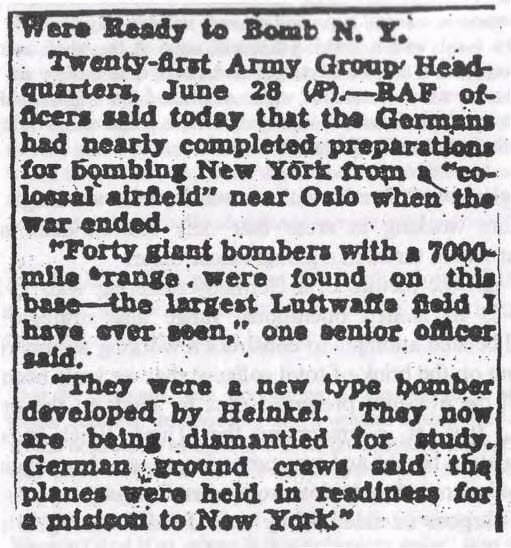
Norway, however, remained in German hands up until their very surrender, and thus constituted the only remaining base of operations available to the Germans for any type of offensive operation against the North American continent.
Although eight He-177 A6 airframes were converted to He-277 at Rechlin, orders were given in July 1944 to stop manufacture and scrap the aircraft.
One of those airframes, a modified He 177 'Greif’ unit, became a donor fuselage for the Ju-287 V1 jet bomber.

The Ju 287 V1's tail was that of a Ju 388G and the main wheels came from a Ju 352 transport. The nose wheel came from a crashed or captured B-24 Liberator.
The Ju-287 V1 was test flown through August to October 1944 when test flying suddenly stopped.
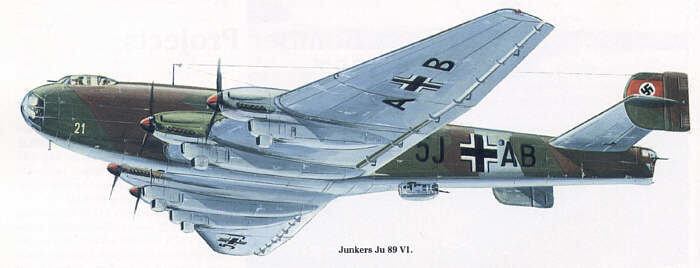
The construction of this airfield so late in the war, suggests a connection to the Atom bomb program:
Hans Kammler would have had jurisdiction over it.
It is also significant that contol over all long range aircraft was also in Kammler's hands by war's end.
This links the precious long-range bombers on the Oslo field to Kammler as well.
The Heinkel He-177 was built to Ural Bomber requirements:
A long range four engine strategic bomber.
A Langstrecken-Grossbomber [long-range heavy bomber] was needed to fulfill this role.
The two companies responded with the Dornier Do 19 and the Junkers Ju 89, respectively, and the Reichsluftfahrtministerium [RLM] ordered prototypes for both aircraft in 1935.
The RLM request asked for two prototypes and a prototype series of nine aircraft.
His successors -Ernst Udet and Hans Jeschonnek- favoured smaller aircraft, since those did not require as much material and manpower. Also they were proponents of the dive bomber [Ju 87 Stuka] and the doctrine of close support and destruction of the opposing airforces on the battle-ground rather than through attacking enemy industry.
While Göring's beliefs seemed validated by Germany's early successes in the Blitzkrieg, the lack of strategic bombing capability severely hampered the Luftwaffe in the Battle of Britain.
Although eight He-177 A6 airframes were converted to He-277 at Rechlin orders were given in July 1944 to stop manufacture and scrap the aircraft. One of those airframes, a modified He 177 ‘Greif’ unit, became a donor fuselage for the Ju-287 V1 jet bomber.
The Ju 287 V1's tail was that of a Ju 388G and the main wheels came from a Ju 352 transport. The nose wheel came from a crashed or captured B-24 Liberator.
He 177 V38

An A-5 [V38] documented use was as a test-bed for a FuG 200 Hohentwiel ASV maritime patrol radar with flexible MG 131Z nose gun installation.
It was speculated to have been intended for the installation of an enlarged bomb bay for test purposes, said to be intended for use in the Junkers Ju 287.
A common myth claims V38 was the prototype of a German "Atomic Bomber" [purportedly capable of carrying a fission device as a droppable weapon].
In terms of the He-177, Heinkel developed two versions with four separate engines.
These were the He-177 A8 which became redesignated in August 1943 as the high altitude He-277.
It had huge commonality with the He-177 A6 and could be converted from earlier He-177, changing the tail, engines and installing a pressurized cockpit. A short series of seven production aircraft came from the conversion of further He-177 airframes.
These finished He-277 B-5 aircraft were in many ways superior to America's B-29s and could bomb from an altitude of 47,500ft, five thousand feet higher than the best Spitfires could intercept.
Although eight He-177 A6 airframes were converted to He-277 at Rechlin, orders were given in July 1944 to stop manufacture and scrap the aircraft.
One of those airframes, a modified He 177 "Greif"’ unit, became a donor fuselage for the Ju-287 V1 jet bomber.
The Ju 287 V1's tail was of a Ju 388G; the main wheels came from a Ju 352 transport.
The nose wheel came from a crashed or captured B-24 Liberator.
The Ju-287 V1 was test flown through August to October 1944 - then test flying suddenly stopped.
However, in March 1945, for reasons not entirely clear, the 287 program was restarted.
The RLM issued a requirement for mass production of the jet bomber [100 airframes a month] as soon as possible.
The V1 prototype was taken out of storage and transferred to the Luftwaffe evaluation centre at Rechlin.
It was destroyed in an Allied bombing raid before it could take to the air again.
The other derative was the He-177 A-4 which was developed near Toulouse.
It had a much longer span wing and different undercarriage plus the “H” tail layout.
It was structurally much different from the He-277 with longer range and was intended to be the New York Bomber.
It was a proposed high altitude pressurized version, never built under the designation, and later developed into the Heinkel He 274
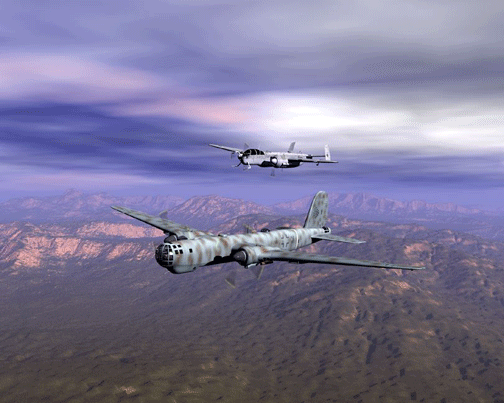
Heinkel, He-177 Greif" with a He-219A escort
One He177 was secretly being readied in Czechoslovakia to carry the planned
German Atomic bomb towards the war's end
Its remains were found at Prague's Ruzynì field on V-E Day.
The other derative was the He-177 A-4 which was developed near Toulouse.
It had a much longer span wing and different undercarriage plus the “H” tail layout.
It was structurally much different from the He-277 with longer range and was intended to be the New York Bomber.
It was a proposed high altitude pressurized version, never built under the designation, and later developed into the Heinkel He 274.
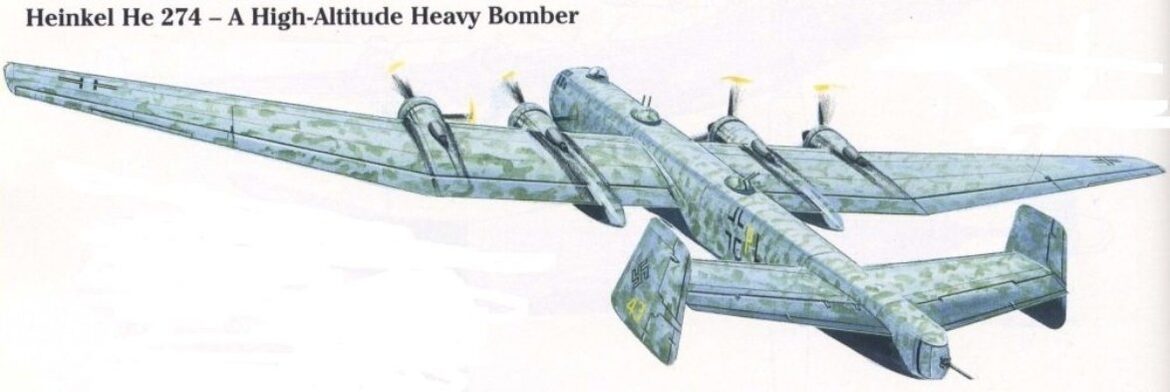
With either of these types the problem really was that they were developed too late.
By the time they emerged aircrew were scarce and fuel even more so. History books are silent on the ultimate fate of He-277 survivors
The loss of France to Allied forces in 1944 deprived the Luftwaffe of its large French airfields. Norway, however, remained in German hands up until their very surrender, and thus constituted the only remaining base of operations available to the Germans for any type of offensive operation against the North American continent.
It is known that a project was developed in Norway to fit He-177 airframes with wings developed for the Me-264, the He-274 intended as a high altitude bomber capable of a mission to New York. It had far less parts in common with the He-177 than the He-277.
It is therefore it is unclear whether the gathering of 40 long range "Heinkel" bombers in Norway by the end of WW2 refers to this He-177 hybrid, or surviving He-277 aircraft or both types.
Sänger 'Silverbird' Orbital Bomber
In June 1935 and February 1936, Dr. Eugen Sänger published articles in the Austrian aviation publication "Flug" on rocket-powered aircraft.
This led to his being asked by the German High Command to build a secret aerospace research institute in Trauen to research and build his 'Silverbird', a manned, winged vehicle that could reach orbit.
Dr. Sänger had been working on this concept for several years, and in fact he had began developing liquid-fuel rocket engines.
From 1930 to 1935, he perfected [through countless static tests] a "regeneratively cooled" liquid-fueled rocket engine that was cooled by its own fuel, which circulated around the combustion chamber.
This engine produced an astounding 3048 meters/second [10000 feet/second)]exhaust velocity, as compared to the later V-2 rocket's 2000 meters/second [6560 feet/second]. Dr. Sänger, along with his staff, continued work at Trauen on the 'Silverbird' under the Amerika Bomber program.
The Sänger Amerika Bomber [or Orbital Bomber, Antipodal Bomber or Atmosphere Skipper] was designed for supersonic, stratospheric flight. The fuselage was flattened, which helped create lift and the wings were short and wedge shaped.
There was a horizontal tail surface located at the extreme aft end of the fuselage, which had a small fin on each end. The fuel was carried in two large tanks, one on each side of the fuselage, running from the wings aft. Oxygen tanks were located one on each side of the fuselage, located forward of the wings. There was a huge rocket engine of 100 tons thrust mounted in the fuselage rear, and was flanked by two auxiliary rocket engines.
The pilot sat in a pressurized cockpit in the forward fuselage, and a tricycle undercarriage was fitted for a gliding landing. A central bomb bay held one 3629 kg [8000 lb] free-falling bomb, and no defensive armament was fitted. The empty weight was to be approximately 9979 kg [22000 lbs].
An interesting flight profile was envisioned for the "Silverbird". It was to be propelled down a 3 km [1.9 mile] long monorail track by a rocket-powered sled that developed a 600 ton thrust for 11 seconds.
After taking off at a 30 degree angle and reaching an altitude of 1.5 km [5100'], a speed of 1850 km/h [1149 mph] would be reached.
At this point, the main rocket engine would be fired for 8 minutes and burn 90 tons of fuel to propel the "Silverbird" to a maximum speed of 22100 km/h [13724 mph] and an altitude of over 145 km [90 miles], although some sources list the maximum altitude reached as 280 km [174 miles].
As the aircraft accelerated and descended under the pull of gravity, it would then hit the denser air at about 40 km [25 miles] and "skip" back up as a stone does when skipped along water. This also had the added benefit of cooling the aircraft after the intense frictional heating encountered when the denser air was reached.
The skips would gradually be decreased until the aircraft would glide back to a normal landing using its conventional tricycle landing gear, after covering approximately 23500 km [14594 miles].
The final test facilities for full-scale rocket engine tests were being built when Russia was invaded in June 1941. All futuristic programs were canceled due to the need to concentrate on proven designs.
Dr. Sänger went on to work on ramjet designs for the DFS [German Research Institute for Gliding], and helped to design the Skoda-Kauba Sk P.14.
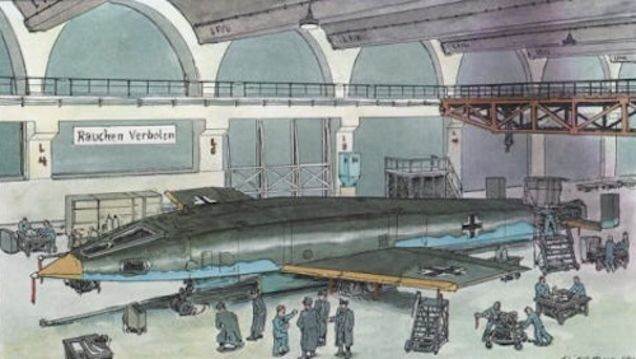 Although the Luftwaffe did its best to stop Dr. Sänger from publishing his research results, a few copies went unaccounted for and made their way to other countries.
Although the Luftwaffe did its best to stop Dr. Sänger from publishing his research results, a few copies went unaccounted for and made their way to other countries.
Whether the "‘Amerika Bomber" would have worked will never be known:
The concept was way too far ahead of available technology to have had much chance of success, particularly in terms of avionics.
Indeed, post-war analysis of the Silverbird design uncovered a mistake in the calculation of the effect of aerodynamic heating during re-entry:
In fact had the 'Silverbird' design ever made it into orbit it would almost certainly had burned up during re-entry.
Furthermore, Germany would certainly have needed to develop an atomic bomb to make the attack worthwhile.
Even if the pilot survived the very high "G" forces on take-off and re-entry, he would certainly be on a one-way mission.
The "Amerika Bomber" was in reality a highly-advanced Kamikaze vehicle.
Nevertheless, when WW2 ended, both the Russians and the Americans studied Sänger’s research with great interest.
After the war, he was asked to work [along with mathematician Irene Bredt] for the French Air Ministry, where in a bizarre plot, he was almost kidnapped by Stalin, who recognized the value of the Amerika Bomber.

Two years after the defeat of Nazi Germany, a claim by a top level US missile defense chief reveals how close we came to nuclear war.
According to a 2 August 1947 newspaper article, a top level official for Air Force alleged that Germans had made plans to launch a nuclear attack from the other side of the Atlantic in order to destroy New York City.
The allegation was made by
Brig. General William L. Richardson
in aCBS science radio show.
As chief of the Guided Missiles Division
in the Office of the Assistant Chief
of the Air Staff for Operations
atArmy Air Force headquarters, Richardson is clearly a person who
ought to know what he was talking about.
Joining the War Department General staff in June 1941, General Richardson was assigned to the Planning Branch of the Operations and Training Division.
Going to England in August 1942, General Richardson was assigned to the Eighth Air Force staff where he organized and trained its airdrome defense units.
The following February he went to North Africa to study air defense operations, and in March 1943 returned to Fort Bliss, Texas, to organize and train the 51st Anti-Aircraft Artillery Brigade. Four months later this brigade was assigned to the Fourth Air Force, which was defending the West Coast and training Air Force units for overseas theaters.
In December 1943, General Richardson organized and trained the Ninth Air Defense Command of the Ninth Air Force, and planned the air defense operations for the continental invasion".
According to Richardson, the Germans had developed a two-stage rocket known as the "A" series, a progression of advanced rocketry. This series included the V-2 rockets which were used to devastate London and other cities in Great Britain.
It is not hard to visualize what might have been in store for the Allies had the Germans been given sufficient time to complete developments.
The article is quite specific. Richardson explains that each of the "'A" series was developed primarily for research. However, the A-4, was the only rocket design that actually became operational when it was re-named the V-2. The A-series, according to Richardson, was to culminate in the A-10, a weapon to bomb New York City from launch sites in Europe.
The project was, in fact, codenamed "Projekt Amerika" with a launch date of 1946. [The rocket reportedly had one weakness, its guidance system was inaccurate at such long distances, requiring a pilot to make the one-way trip across the Atlantic].
Although that weapon was never actually constructed, all design studies and computation had been completed. So how close did they come to realizing the goal?
Richardson claims that the A-10 "could have been built and served its purpose provided the German had been given another year of development and production".
Of course, some historians -with the advantage of historical perspective and later uncovered evidence- might not concur with Richardson's assessment.
The official described the rocket in great detail.
The total weight of the A-10 was to have been 190,000 pounds of which 140,000 was to be fuel. It was nearly 12 feet in diameter and 25 feet long. The rocket would have had a speed of 2.500 miles an hour in the first stage and then accelerating to 6,000 miles an hour in the second stage.
Richardson claimed that the rocket would have carried a payload of 2,000 pounds.
In the final line of the article, Richardson adds, rather nonchalantly: "..there is evidence to believe.. that the Germans intended to utilize an atomic warhead which would have made the weapon a very serious menace".
Unfortunately, there is no further elaboration on that claim. Yet, considering the source, Richardson's remark is an interesting one.
Most military historians believe that the German race to develop a nuclear weapon was pretty much a dead issue as early as late 1941. However, that view has been a matter of some controversy
For example, a 2005 book by Rainer Karlsch entitled "Hitler's Bomb", claims that German researchers conducted a successful nuclear weapon test of some type of a nuclear-related device in Ohrdruf, Thuringia on 4 March 1945.
Despite supposed eyewitness testimony, no other evidence that Nazis possessed the capacity to build a nuclear weapon has been found.
That's not to say that the Nazis could not have created a nuclear catastrophe on American soil.
Even without an actual atomic weapon, there were other threats. For instance, the use of a dirty bomb -part of Karlsch's theory- would have rendered much of Manhattan and the other boroughs uninhabitable for a long time.
Fortunately for New Yorkers, the prospect of dealing with a rocket carrying of a payload of 2,000 pounds of drifting radioactive dust was -if Brig. General Richardson is correct- was narrowly avoided.
Adolf Hitler's plot to bomb New York
Newly discovered papers reveal the Nazis’ most bizarre plan – sending manned rockets into space to attack America
By David Robinson
Daily Express
4 January 2013
The head of the Luftwaffe Hermann Göring banged his fist on the table in anger.
He needed a dynamic new scheme to catch the Führer’s eye.
In the Third Reich, competition between the German army and the German air force – the Luftwaffe – was fierce.
Senior Nazis vied and tussled for influence throughout the Second World War.
At the end of 1941, Göring’s Luftwaffe was in trouble.
It had lost the Battle of Britain, while the German army was –according to Nazi propaganda from the eastern front– rampaging triumphantly across Russia.
"Göring was looking for anything and everything to redeem the apparent failings of his Luftwaffe", says historian Dr David Baker.
The United States had just joined the war following the attack on Pearl Harbor and the Führer wanted a long-range bomber build to attack America’s eastern seaboard.
"Hitler was bitterly contemptuous of America", Dr Baker adds.
By successfully attacking the US, Göring could consolidate his position within the Third Reich.
But the Luftwaffe relied on slow, piston-powered aircraft with limited range – and a round trip from Berlin to New York was more than 7,000 miles.
The US was simply too far away.
A major technological innovation was required and Göring sent his technical staff scurrying away to find solutions.
A few years earlier, an Austrian engineer named Eugen Sänger had published a paper proposing a manned, rocket-propelled space-plane that could in theory fly anywhere in the world.
“"Sänger was the first to look into the technicalities of building a winged, reusable sub-orbital vehicle", says Dr Asif Siddiqi, an assistant professor in space history at Fordham University.
"“His work was extremely far-sighted".
How much Göring actually understood of Sänger’s ideas is unclear but he was hired and put to work at a laboratory near Hamburg with a small support team –including physicist Irene Bredt, his later wife– and told to come up with a blue-print for an inter-continental bomber.
This bomber was also to be armed with a radio-active bomb capable of doing untold damage to America's most populous city.
Leading historians told the "Daily Express" that Göring was gullible for believing the far-fetched plan would work.
However much of the research which went into the project paved the way for modern space travel research and the space shuttle program.
"Sänger was a fantastic mathematician", says aviation historian David Myhra.
"But his first love was space. He wanted to explore the universe in rockets. He was obsessed with science fiction. He was a dreamer".
The 900-page plan that Sänger eventually submitted to the Air Ministry could have flown straight out of the pages of "Flash Gordon".
In order to bridge the Atlantic he proposed sending a manned, rocket-powered jet into the lower reaches of space.
The sub-orbital bomber was to be named the 'Silverbird' because of its metallic appearance.
The Silverbird was to be launched on a huge sled attached to a two mile mono-rail powered by 36 V-2 rocket engines.
The awesome, fiery blast would propel the craft forward at a coma-inducing 1,200 miles per hour.
At the end of the rail, the space-plane would start climbing.
Thirty seconds after lift-off the craft’s own 100-tonne thrust motor would kick in.
Eight minutes after ignition the Silverbird would have reached an altitude of more than 80 miles above Earth – the commonly accepted boundary between Earth and space is 62 miles above sea level.
This allowed it in theory to skip across the atmosphere like a stone bouncing over a pond.
“The standard aircraft of the day could not fly from Europe to the US because they could not carry enough fuel", explains Myhra, who has written a book on the Silverbird.
"By reaching sub-orbital altitude the Silverbird’s fuel life would be extended allowing it to bomb anywhere in the world".
If the space-plane concept wasn’t far out enough, the bomb it was carrying was out of this world.
"The plan was to wrap the bomb with radio-active sand and have it explode high above New York casting a radio-active cloud over the city", Myhra says.
"It was a kind of prototype dirty bomb".
The Silverbird would have been travelling at a jaw-rattling 13,000 miles per hour.
Once it had dropped its payload the Silverbird would descend under the pull of gravity, re-enter the atmosphere and glide back to Japanese territory in the Pacific.
“It was wild science fiction", Myhra says.
“But Sänger had worked out all the mathematics. He was certain it would work".
Göring, however, struggled to get his head around the concepts.
By spring 1942 the rotund art-lover had a lot on his plate.
The war in Europe was not going well and he was under intense pressure to stop Allied bombing raids on German cities.
"Göring saw the Silverbird as an implausible scheme with too many uncertainties", Dr Baker says and the plan was left on the shelf.
"The Silverbird idea was theoretically possible", Myhra adds.
"Post-war analysis indicated that the space-plane would have burnt up during re-entry but this could have been overcome with thermal shielding.
"The underlying concept was sound but it was many years ahead of its time".
The Nazis would look to other schemes to bomb the US but never succeeded.
Sänger carried on tinkering with his concept and an abridged, 125-page outline was submitted to the Air Ministry in 1944 as the conflict entered its final stages.
A copy of this top-secret document would fall into the hands of the Americans and the Russians who were advancing on Berlin.
At the end of the war in 1945 Sänger fled to France but his bizarre story doesn’t end there.
By this stage, Soviet dictator Josef Stalin had taken an interest in the Silverbird.
The Cold War was just beginning.
Stalin ordered his agents to kidnap the Austrian and bring him to work in the Soviet Union.
But the bungling agents failed to locate him and he stayed safely in the West.
The Soviets would spend a lot of resources trying to build a copy of the bomber.
But by the early Fifties, Russian engineers gave up, concluding that the technology required to build it was yet to be invented.
In America Sänger’s work on the Silverbird was scrutinised.
"Sänger would greatly influence post-war thinking about space travel in the United States.
"A whole series of highly classified spaceplane concepts were developed based on his theories", says Dr Baker.
"His work certainly had an influence on aspects of the Space Shuttle programme".
Sänger’s legacy is still felt today.
In December the US military launched its secretive X-37B unmanned space-plane on its third test flight.
"The ideas developed by Sänger during the war have led the US through a succession of space plane prototypes that ultimately led to the X-37B", says Dr Roger Launius, senior curator at the Space History National Air and Space Museum in Washington.
Eugen Sänger died in 1964.
He did not live to see the wide-ranging influence his visionary ideas would have on aviation, rocketry and space travel.
"The whole concept of space-plane technology was really started by Sänger", Dr Baker adds.
"He played a vital role in space aviation development".
The A9/10
The A9 was a winged version of the Peenemünde-designed A4 [V-2] missile.
The V-2 would fly a simple ballistic trajectory after its fuel was expended, like a giant artillery shell, falling on a target some 200 miles away at about three times the speed of sound [2,000 mph].
Although this tremendous speed added greatly to the destructive power of the missile, there was another way it could be used.
By adding wings to the missile and modifying the guidance system, the designers redirected the kinetic energy of the falling projectile into extra range.
As the rocket encountered thicker air on its descent, it would execute a high-g pullout and enter a shallow glide. In this way, speed could be traded for distance.
While the rocket would reach its target at subsonic speed, and might therefore be vulnerable to defenses, it would be able to strike a target some 400 miles away only seventeen minutes after launch.
Design studies began as early as 1940.
In addition to the wing modifications, the A9 would have been somewhat larger than the V-2 and its engine would have produced about thirty percent more thrust.
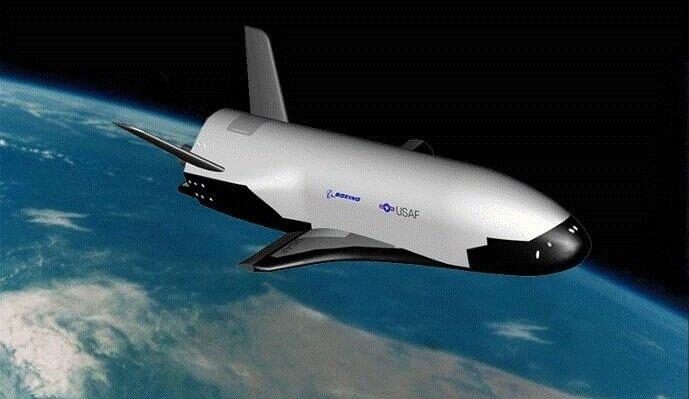
Following World War II, many German scientists were taken to the United States by the Office of Strategic Services' "Operation Paperclip".
Among them was Dr. Walter Dornberger, the former head of Germany's wartime rocket program, who had detailed knowledge of Eugen Sänger's Silbervogel project.
Working for Bell, he attempted to create interest in a boost-glide system in the USAF.
The development of "Dyna Soar" can be traced back to the Silbervogel bomber project of World War II.
The concept was a rocket-powered bomber that could travel vast distances by gliding to its target after being boosted to high speed [>5.5 km/s] and high altitude [50–150 km] by A-4 or A-9 rockets.
A design study also was initiated for a manned A9.
This version replaced the 2,200 lb warhead of the V-2 with a pressurized cockpit.
There are no indications of a camera in the drawings, but some sources indicate the intended mission of this extra-ordinary high-performance manned missile was strategic reconnaissance.
A ramjet engine and associated fuel tankage were to be added to provide power for cruise flight, and landing gear and flaps to enable landings on conventional runways.
The vehicle would have had performance comparable to the US X-15 experimental hypersonic rocket plane of the late 1950s.
An even more advanced version of the A9 was planned to be used to attack the US from launch sites in Europe.
In order to do so, an additional booster stage, the A10, was necessary.
An initial report on the concept was issued by Peenemünde's propulsion expert, Dr Thiel, on 18 December 1941, immediately after the US entered the war.
The manned version of the missile would be equipped with a pressurized cockpit, featuring life-support systems, and cartographic radar.
Also, an ejection seat, allowing a pilot to bail out shortly before impacting the target.
The Germans had devices ready which would take care of pilots forced to even leave supersonic planes in flight.
Normally a pilot who stuck his head out at such speeds would have it shorn off; his parachute on opening would burst in space.
"To prevent these calamitous happenings an ejector seat had been invented which flung the pilot clear instantaneously. His chute was already burst, that is, made of latticed ribbons which checked his fall only after the down-drag of his weight began to close its holes".
-- 'War Secrets by the Thousands' - "Harper's Magazine", October 1946
The original concept of the A-10 rocket envisioned a test version with a propulsion system made of six combustion chambers.
The complexity of the rocket forced the Nazi leadership to abandon the idea around 1943, so the development center could concentrate on the all-but flight- ready A-4.
However, the design may have been further along than historians have admitted.
The inter-continental A9 was equipped with radically modified, highly-swept wings for a transatlantic glide beginning at hypersonic [greater than Mach 5] speeds and was nested in the nose of the A10.
The A10 itself was about 65 feet long and was equipped with a 375,000 lb thrust rocket engine burning Diesel-grade oil and nitric acid. During its 50 second burn, it could accelerate the A9 to a speed of about 2,700 mph and an altitude of about 15 miles. With the A9 installed, the composite rocket would have stood about 84 feet tall.
On 8 January 1945, reporters, hovered around Admiral Jonas Ingram, commander of the Eastern Sea Frontier, in his wardroom aboard a warship in New York harbour.
The scribes had come for what Ingram's public-relations staff had promised would be "a historic press conference".
Ingram, a heavy-set, flat-nosed old salt who had gained national recognition as football coach at the Naval Academy in Annapolis, Maryland, was one of the Navy's colourful characters - and most outspoken.
Seated behind a long table, Ingram said:
"Gentlemen, I have reason to assume that the Nazis are getting ready to launch a strategic attack on New York and Washington by robot bombs".
There was a gasp of astonishment from the reporters.
"I am here to tell you that these attacks are not only possible, but probable as well, and that the East Coast is likely to be buzz-bombed within the next thirty or sixty days".
Ingram eyed his listeners, then added grimly:
"But we're ready for them.
"The thing to do is not to get excited about it.
"[The Buzz-bombs] might knock out a high building or two, might create a fire hazard, and most certainly would cause casualties.
"But [the Buzz-bombs] cannot seriously affect the progress of the war".
The hard-nosed Ingram added that "it may be only ten or twelve buzz-bombs, but they may come before we can stop them".
"At any rate", the admiral concluded, "I'm springing the cat from the bag to let the Huns know that we are ready for them!".
Coach Ingram's announcement triggered a media sensation.
On 9 January 1945, the "New York Times" ran the story with the headline:
"Robot Bomb Attacks Here Held Possible"
"Buzz-bomb" is the name the Allies gave to Germany’s jet-propelled V-1 guided missile.
In January 1945, Albert Speer made a propaganda broadcast, claiming that V-1 and V-2s "would fall on New York by 1 February 1945".
This increased the U.S. Government's concern over the threat of attack.
The Germans had unofficially test-fired six underwater missiles as early as summer 1942 with the 30cm Wurfkörper 42 Spreng mounted on the deck of the Type IXC U-551.
This idea came from Dr. Ernst Steinhoff who worked for Peenemünde.
Dönitz was convinced that these rockets could be further developed into anti-convoy weapons.
The test rocket launches had been successful, both on the surface and submerged to a depth of 12 meters [40 ft].
This in turn led to "Project Ursel" as a missile specifically designed to be launched from a U-Boat against a pursuing surface vessel.
The missile would be of 165mm caliber and four of them would be mounted on the deck in a special tube launcher.
The SP-Anlage detection system was ready,capable of detecting and locating propeller noise with great accuracy.
By factoring in the U-Boat's depth, could work out the target's precise location up to a range of five times the U-Boat's depth.
It was installed on the latter production Type XXI U-Boats.
The missiles for this project were still under development at Peenemünde when the war ended, so no use came of them.
Both the Type XXI and Type XXVI U-Boats would have carried this weapon system.
But greater still was the Prüfstand XII [Test Stand XII] project, suggested by an official of the German Labor Front, Otto Lafferenz in 1943.
It involved towing the missile across the Atlantic in a water-tight container behind an U-Boat, then setting it up vertically for launch against US eastern seaboard targets - particularly, New York.
Due to Kriegsmarine priorities and those of Peenemünde the sub-launched missile was delayed until 1944 when work began on three large containers for the missiles.
The containers would be 105 ft long, displace roughly 500 tons, containing a single V-2 within as well as a control room and fuel tanks.
The three initial containers were to be towed by a single Type XXI U-Boat; the forward speed keeping them submerged until the time to raise and launch against the target.
In addition, it was planned that one of the three containers would carry extra Diesel fuel for the U-Boat for re-supply during the voyage.
Once on station, the U-Boat would quickly surface and stop, allowing the containers to surface.
Crews would then board each container, open the valves to fill the ballast tanks, raising the launchers to vertical position whereby an electrical connection to the U-Boat would be made.
Once that was accomplished the crews would enter the control room and perform their tasks: Fuel the missiles, set the gyroscopic guidance system, and open the electrically-operated doors.
The men would then return to the U-Boat where the rocket would be triggered by remote control.
The Vulkanwerft at Stettin was contracted to build three containers in December 1944 while Blohm und Voss ship-yard was to convert a single Type XXI for the task.
Due to bombing, the U-Boat was not converted and of the three containers, only one was actually completed by May 1945 with two others at 65 percent.
Through shared Intelligence, the Allies knew a great deal about the secret German naval missile program and had drawn up a contingency plan to defeat it.
With "Operation Teardrop" the US would respond with four escort carrier groups to prevent any U-boat penetration into American coasts.
Thus, in March 1945, when a group of six Type IXC U-Boats were detected sailing for American shores, they were promptly hunted with four of the six destroyed.
Two got away, although apparently later, it was not the anticipated missile attack.
After the war, this concept led to the US and Soviet ballistic missile submarines of the 1950s
Hermann Göring realized that if Germany were to be able to attack America, it would need a craft capable of crossing the Atlantic and returning.
Scientist Eugen Sänger thus suggested the "Silbervogel" [Silver Bird].
A more likely carrier for an atomic weapon would have been a rocket with submarine launch capability or a two-stage, long-range rocket like the A-9/10.
The A-9/A-10 rocket represented one of the earliest detailed studies of a multi-stage rocket, capable of crossing the Atlantic Ocean.
According to Wernher von Braun’s own writings, the rocket of this class was envisioned as early as 1936.
The A-9/A-10 concept emerged far ahead of its time, fueled by a dream of some in the WWII German government to bomb America.
In his 1952 book, "V2--Der Schuss ins Weltall" [Bechtle Verlag], Major General Walter Dornberger, commander of the Peenemünde Rocket Research Institute, described what made the A-9 such a fearsome weapon:
"The missile was planned to reach a height of about 20 kilometers [12 miles], a maximum speed of 4,400 kilometers per hour [2,800 miles per hour] and then go into a shallow curving glide with a peak of nearly 30 kilometers [18 miles].
"On arrival over the target, at a height of 5 kilometers [3 miles], it was planned to dive vertically".
"A better plan, however, and one which greatly improved range, was to construct the A-10, weighing 87 tons and with a total propellant capacity of 62 tons, as the first step of the combined A-9/A-10.
"The A-9 was placed on top of the A-10.
"The latter had a thrust of 200 tons for 50 to 60 seconds and gave the rocket a speed of 4,400 kilometres per hour.
"After the exhaustion of the first step [stage or A-10], the A-9 would be ignited and lift out of the A-10".
In today’s parlance, the A-9 was the world’s first intercontinental ballistic missile [ICBM].
In the 1940s, there was no effective defense against a weapon of this type.
The National Socialists’ nicknames for the A-9—"'Amerika Rakete" and "New York Rakete"—left little doubt as to one of its ultimate intended targets.
Just how narrowly America dodged the A-9 "bullet" is one of the most-overlooked stories of World War II.
The United States was spared as an A-9 target, thanks largely to massive Allied bombing raids.
These forced the Germans to relocate their rocket production to bomb-proof facilities laboriously tunneled into solid rock in the sides of mountains, thereby delaying the A-9’s deployment for several crucial months.
Even so, there are reports that successful test flights of the A-9 were made in January and March of 1945—and there’s a tantalizing clue suggesting the Germans may have used at least one other A-9 in combat against a different foe.
A Cold War-era article in a Russian science magazine contained an allusion to the mysterious destruction of a munitions complex near the Ural Mountains sometime in 1945 by a "terror attack" representing "fascist perfidy".
The writer likened it to American B-52 bomber strikes during the Vietnam War.
However, the only National Socialist weapon capable of penetrating more than 2,000 miles of Soviet-controlled airspace at the time was an ICBM.
-- Farrell, Joseph P., "The SS Brotherhood of the Bell", Adventures Press, Kempton, IL, 2006
But even if the Germans succeeded in deploying rockets capable of reaching the U.S. mainland, it would have required a large number of well-targeted strikes to significantly impair the nation’s war-making capacity.
This calculus might well change, however, if the National Socialists were able to fit their rocket warheads with something more destructive than conventional explosives.
As it turns out, National Socialist scientists were hard at work on the same weapon of mass destruction the U.S. was: The atom bomb.
For decades following World War II, the conventional wisdom was that the Germans lagged far behind the Allies in the race to build an A-bomb.
However, recent revelations have called that long-held belief seriously into question.
For decades following World War II, the conventional wisdom was that the Germans lagged far behind the Allies in the race to build an A-bomb. However, some recent revelations have called that long-held belief seriously into question.
As reported by an American newswire service in 1998:
"Once top-secret files on Nazi Germany’s race to build an atomic bomb are being opened to the general public for the first time. The documents suggest that German research into the atomic bomb was "nearly parallel' with efforts in the United States".
-- Associated Press, 17 December 1998
Actually, even that surprising reassessment underestimates German progress in the area of atomic weaponry.
One particularly well-placed American weighed in on the threat of National Socialist atomic weapons development at the time, albeit off the record.
A close friend and confidante of President Franklin Roosevelt recorded the following incident in her diary:
"He had just gotten a secret report from a German source that the Germans had developed a bomb which will kill by concussion everything within a mile. They are planning to use it on New York City. The Germans are way ahead of us in that direction, though we are doing a lot of research to catch [up] to them".
-- Beschloss, Michael, "The Conquerors", Simon & Schuster, New York, 2003.
For his part, Adolf Hitler was apparently quite bullish on Germany’s atomic progress. A doctor who treated the National Socialist leader in the final months of the war later recalled a memorable statement his famous patient made to him in February of 1945:
"In no time at all, I’m going to start using my victory weapon, and then the war will come to a glorious end. Sometime ago, we solved the problem of nuclear fission, and we have developed it so far that we can exploit the energy for armament purposes.
"They won’t even know what hit them. It is the weapon of the future. With it, Germany’s future is assured".
-- Irving, David, "Hitler’s War" Avon Books, New York, 1990.
It is at this point the A-9 rocket/ ICBM once again enters the picture.
The following is from the memoirs of a Spaniard who was a top member of the National Socialist espionage service:
"I had been receiving reports from our men in the United States and South America of a new American secret weapon. The reports hinted at an entirely new type of bomb of devastating destructive power.
"At the same time, I understood that Nazi scientists were working desperately to design a workable nuclear warhead for our rockets".
- Cooper, Harry, "Escape From the Bunker", Sharkhunters International, Hernando, FL, 2010.
In World War II as today, the miniaturization of nuclear weapons presented added technical challenges.
It is a little-known fact that, by late in the war, the Germans had several four- and six-engine planes [one of which reportedly flew to within 12 miles of New York City on a test flight in 1944] capable of carrying a full-size atom bomb and reaching North America.
But they evidently opted for developing smaller tactical nukes delivered by ICBMs— which could not be shot down—rather than larger atom bombs carried by aircraft, which could be shot down.
-- Stevens, Henry, "Dark Star", Adventures Unlimited Press, Kempton. IL, 2011.
[The U.S. had no such delivery system option for its atomic weapons during World War II].
If what one group of eyewitnesses reported is true, the Third Reich’s scientists did in fact succeed in miniaturizing an atomic weapon for a rocket warhead in order to achieve Hitler’s goal of hitting the U.S. homeland.
The account, which appeared in a French magazine in 1958, described how a V-2 rocket [a smaller single-stage predecessor of the A-9] destroyed a collection of structures built to simulate a small town.
The source of the account was apparently one or more French POWs employed as laborers by the National Socialists in northern Germany.
According to the article:
"The rocket landed almost in the center of the buildings with a deafening detonation. There was a huge flame, and everything was covered with a dense, gray, heavy smoke, while a warm, breath cutting puff of air spread rapidly.
"It took more than one hour for this dense curtain to clear. From the buildings, only debris remained. Metallic constructions stuck out of the ground, shapeless and melted.
"The tall trees were no more than burned trunks. At the point of impact, the ground was . . . furrowed with deep crevasses, actually burning in some points and dug as if subjected to an enormous pressure.
"The cars parked in the street were reduced to debris or violently thrust by the explosion against the houses on fire. The concrete train station had partly collapsed.
"The locomotives had resisted the blow, but the smashed and tipped-over [railcars] showed their insides.
-- Stevens, Henry, "Hitler’s Suppressed and Still-Secret Weapons, Science and Technology", Adventures Unlimited Press, Kempton, IL, 2007.
Further confirmation of the Germans’ tactical nuke-ICBM approach comes from a French civilian who worked for the Germans during the war.
He said he saw blue-prints for a specially designed rocket-launching site scheduled to be built near the western coast of occupied France—a fine location from which to launch rockets across the Atlantic toward North America. [V-2s were fired from mobile launchers when used in combat].
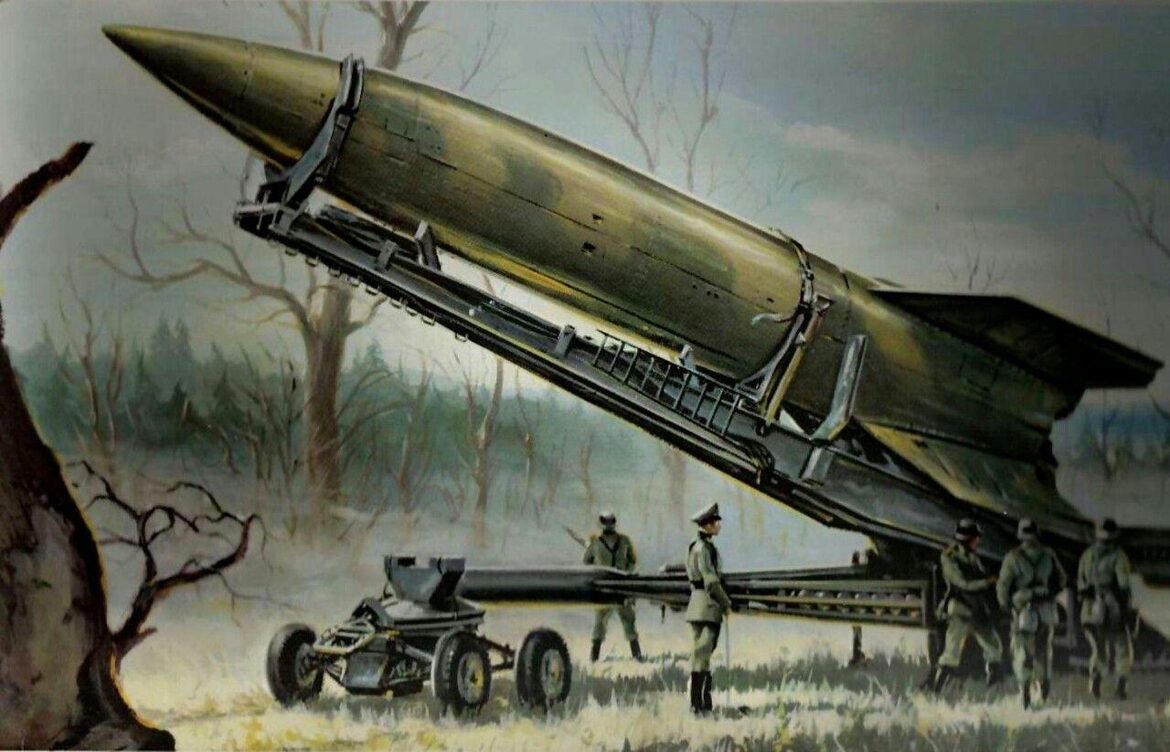
In addition, he recalled German engineers assigned to the project boasting that the National Socialists were developing a powerful new weapon capable of destroying everything within a 1/2-mile radius of the target—a damage pattern more indicative of a small tactical nuke than either conventional explosives or a full-size atom bomb.
-- Henshall, Philip, "Vengeance", Sutton Publishing, Phoenix Mill, UK, 1998.
Apart from any physical damage inflicted on war production facilities, nuclear missiles raining down on U.S. cities without warning could be expected to take a toll on morale and support for the war.
A document captured by U.S. forces in Germany showed just how precisely the National Socialists planned the delivery of their nuclear warhead-equipped ICBMs.
It included a detailed map of New York City with a bull’s-eye positioned near Delancey Street and the Bowery in lower Manhattan.
-- Stevens, op. cit.
Hitler tried to sustain morale by promising that "secret weapons" would turn the war around. He did indeed have the weapons.
The first of 9,300 V-1 flying bombs hit London in mid- June 1944, and together with 1,300 V-2 rockets caused 8,000 civilian deaths and 23,000 injuries.
Although they did not seriously undercut British morale or munitions production, they bothered the British government a great deal--Germany now had its own unanswered weapons system.
Using proximity fuzes, British ack-ack gunners [many of them women] learned how to shoot down the 400 mph V-1s; nothing could stop the supersonic V-2s.
The British government, in near panic, demanded that upwards of 40% of bomber sorties be targeted against the launch sites, and got its way in "Operation Crossbow"
The attacks were futile, and the diversion represented a major success for Hitler.
In early 1943 the strategic bombers were directed against U-Boat pens, which were easy to reach and which represented a major strategic threat to Allied logistics.
However, the pens were very solidly built--it took 7,000 flying hours to destroy one sub there, about the same effort that it took to destroy one-third of Cologne.
The anti-submarine campaign thus was a victory for Hitler.
-- Webster, Charles and Noble Frankland, "The Strategic Air Offensive Against Germany, 1939-1945" [HMSO, 1961]
Every raid against a V-1 or V-2 launch site was one less raid against the Third Reich.
On the whole, however, the secret weapons were still another case of too little too late.
The Luftwaffe ran the V-1 program, which used a jet engine, but it diverted scarce engineering talent and manufacturing capacity that were urgently needed to improve German radar, air defense, and jet fighters. The German Army ran the V-2 program.
The rockets were a technological triumph, and bothered the British leadership even more than the V-1s. But they were so inaccurate they rarely could hit militarily significant targets.
Furthermore, the program used up scarce technical resources that could have gone into the development of air defense weapons like proximity fuzes and "Wasserfall", a deadly ground-to-air rocket.
The secret weapon of greatest threat to the Allies was the jet plane that could outfly Allied fighters and shoot down bombers.
The Messerschmitt ME-262 prototype flew in 1939, but was never given high priority until too late.
Hitler never understood air power; his personal interference repeatedly delayed the jets. First he proclaimed they would not be necessary, then insisted they be redesigned as bombers to make retaliation raids against London.
The Luftwaffe would have been a much more deadly threat if it built ten thousand jets; it only made one thousand and they rarely flew combat missions.
UK proposed using atom bomb against Germany
By Chris Hastings and Fiona Govan
The Telegraph
2 December 2002
Britain considered using the atomic bomb against Germany in retaliation for Hitler's deployment of V2 rockets against London, according to newly declassified documents.
The diaries of Guy Liddell, the head of the espionage "B" branch of MI5 between 1939-1945, reveal that concern about the Nazis' V2 program was so great that the possibility of using the nuclear bomb as a deterrent was discussed with Winston Churchill.
It was even suggested that Churchill would raise the idea of using the bomb, which had been in development in the United States since 1942, with American president Franklin Roosevelt.
The proposal was discussed in August, 1944, when British agents were reporting that Hitler was poised to launch the supersonic V2 rockets at London.
Britain had no effective counter-measures against the rocket-propelled V2s which, because they travelled faster than the speed of sound, detonated without warning.
An alarmed Mr Liddell asked MI6 head Sir Stewart Menzies if a nuclear threat could be used against Hitler. Mr Liddell and Sir Stewart - referred to as "C" - were among the few people in Britain who knew that the Allies were developing an atomic weapon.
"I saw 'C' today about the Uranium bomb and put to him the suggestion that it should be used as a threat of retaliation to the Germans if they used V2", Mr Liddell recorded in his diary.
Less than two weeks later, on 7 September 1944, Hitler began "Operation Penguin", raining hundreds of V2 rockets down on Britain. During the seven months leading up to the end of the war in Europe, more than 3000 were launched, killing 2,274 people in London alone.
The documents do not record the result of Sir Stewart's discussion with Churchill. However, the suggestion came at a time when Britain was already engaged in a campaign of destruction against German cities. The campaign was so devastating that some German historians now argue that Churchill should be seen as a war criminal.
Churchill also stoutly defended the Americans' use of the atomic bomb against the Japanese cities of Hiroshima and Nagasaki in August, 1945, supporting its deployment on military, political and moral grounds.
On 10 August, the day after the Nagasaki bombing, Churchill argued that the horrific death toll was militarily justified if it helped to bring the war to an early close.
He also reportedly complained to a friend that the Americans had failed to make sufficient political use of their new-found power: he would have threatened Russia with the device to make Stalin "behave reasonably and decently in Europe".
As for the morality of using the atomic bomb, Churchill told Lord Mountbatten in 1946 that it was a serious question for history but added: "I may even be asked by my Maker why I used it, but I shall defend myself vigorously and shall say, 'Why did you release this knowledge to us when mankind was raging in furious battles?' "
Historian Andrew Roberts agreed that Mr Liddell's suggestion would have been taken seriously due to the threat the V2 posed.
"The release of these documents is highly significant - I was certainly not aware that the British were discussing this idea. But I think the way contemporaries felt about the V2 was not that different from the way they felt about nuclear weapons: the V2 rocket was Hitler's deadliest weapon", he said. "I think it's undeniable that if the Allies had had the atomic bomb a year earlier, the war in Europe would have ended there and then.
"In the end the threat wasn't made because the bomb still wasn't fully operational".
The "Manhattan Project" - established in 1942 in response to warnings that the Nazis were trying to develop a nuclear weapon - was far from complete. The Allied physicists were having considerable difficulty accumulating sufficient fissile material for a bomb.
Liddell and MI5 did not know this in August 1944. His diary entries, which include a mention of Prof Niels Bohr, the Nobel Prize winning physicist, indicate that he thought work on the bomb was far advanced.
The first successful test of an atomic device would not take place until almost a year later at Los Alamos, New Mexico, on 16 July 1945 - after the war in Europe had ended.
The first use of the atom bomb was at Hiroshima on 6 August 1945, when 200,000 Japanese were killed. A second bomb of a different type was exploded above Nagasaki on 9 August - five days later the Japanese surrendered.
An estimated 2,754 civilians were killed in London by V-2 attacks with another 6,523 injured, which is two people killed per V-2 rocket.
The German V-weapons [V-1 and V-2] cost $3 billion [wartime dollars] and was more costly than the Manhattan Project that produced the atomic bomb [$1.9 billion]. 6,048 V-2s were built, at a cost of approximately 100,000 Reichsmarks [GB£ 2,370,000 (2011)] each; 3,225 were launched.
SS General Hans Kammler, who had a reputation for brutality, had originated the idea of using concentration camp prisoners as slave laborers in the rocket program.
The V-2 is perhaps the only weapon system to have caused more deaths by its production than its deployment. The V-2 consumed a third of Germany's fuel alcohol production and major portions of other critical technologies: to distil the fuel alcohol for one V-2 launch required 30 tonnes of potatoes at a time when food was becoming scarce.
Those who were seriously engaged in the war were very grateful to Wernher von Braun. Each V-2 cost as much to produce as a high-performance fighter airplane.
They knew that German forces on the fighting fronts were in desperate need of airplanes, and that the V-2 rockets were doing no military damage. From that point of view, the V-2 program was almost as good as if Hitler had adopted a policy of unilateral disarmament.
Hitler's secret flying saucer: Did the Führer plan to attack London and New York in UFOs?
By Allan Hall for MailOnline
18 November 2010
As Hitler's armies began to crumble on fronts as far apart as Stalingrad and North Africa, he turned in increasing desperation to his scientists to create a war-winning super-weapon.
Some, like the V2 rockets and the first jet fighters, saw action but came too late to halt defeat.
Others were so outrageously ambitious that they never got past the drawing board. The idea of building flying saucers to bomb London and even New York could have been just such a scheme.
But now it is claimed that Hitler’s scientists had indeed designed this type of aircraft – and were so far advanced with the project that a prototype may even have flown.
The program, under the command of SS officer Hans Kammler, was said to have made significant breakthroughs with their experiments, says a report in the German science magazine "PM".
"The Americans also treated the existence of the weapons seriously", it adds.
At the time the "New York Times" had written about a "mysterious flying disc'"and published photos of the device travelling at high speeds over the city’s high-rise buildings.
The magazine says that the Germans destroyed much of the paperwork on their activities but in 1960 in Canada UFO experts managed to recreate the device which, to their amazement, 'did actually fly'.
The project was called the Schriever-Habermohl scheme. Rudolf Schriever was an engineer and test pilot, Otto Habermohl an engineer. It was based in Prague between 1941 and 1943.
Initially a Luftwaffe plan after Hitler ordered his airforce chief Hermann Göring to come up with a super-weapon, it was eventually taken over in 1944 by Kammler.
Prisoners of the Allies claimed to have seen the silvery flying saucer, which was about six yards across, on several occasions.
Josef Andreas Epp, an engineer on the project, said 15 prototypes were built.
He described how a central cockpit was surrounded by rotating adjustable wing-vanes which formed a circle and gave the craft lift.
The vanes were held together by a band at the outer edge of the wheel-like device.
The pitch of the vanes could be adjusted so that during take off more lift was generated by increasing their angle from a more horizontal setting.
In level flight the angle would be adjusted to a smaller angle, similar to the way helicopter rotors operate.
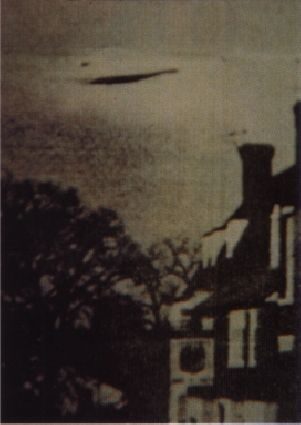
UFO over England - 1944
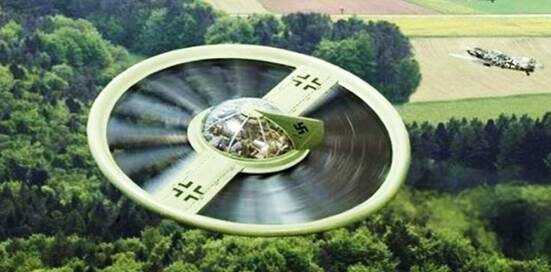
The wing-vanes were to be set in rotation by small rockets placed around the rim like a pinwheel.
Once rotational speed was sufficient, lift-off was achieved.
After the craft had risen to some height the horizontal jets or rockets were ignited.
"After this the wing-blades would be allowed to rotate freely as the saucer moved forward as in an auto-gyrocopter.
"The wing-blades speed, and so their lifting value, could also be increased by directing the adjustable horizontal jets slightly upwards to engage the blades, thus spinning them faster at the discretion of the pilot", he said.
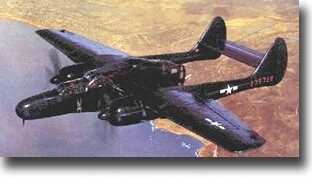
England entered the war long before the U.S. What became known as "Foo Fighters" were reported by the British as early as September 1941, with regular sightings by all sides continuing, except for a several month lull in 1943, throughout the war.
On the U.S. side, although sightings occurred periodically before the deployment of P-61 Black Widows in Europe, it was the night fighter pilots of "Black Widows"' that were among the first American military men to regularly report seeing Foo Fighters, saying "unknown objects" followed or paralleled their planes and glowed in the dark.
Interestingly enough, with all the sightings and reports, and all the gun cameras and high altitude photographs, no truly good pictures of foo-fighters from the period have surfaced.
There is a rich vein of declassified material respecting foo-fighters. Very many reports have been released by the US and British archives. But for the most part they all have the same failing: they have been heavily censored.
If we were dealing here with a natural phenomenon such as Weather Plasma, these reports would not have required the savage deletions to which they have been subjected.
A deletion in an official document is made to protect the issuing authority in some way. It may be an agent's name: it may be something underhanded that was done: it may be information respecting a weapon which the authority does not wish to be made public.
Both the US and British authorities are agreed in their published summaries regarding the "foo-fighter" phenomenon that the objects were "invulnerable".
No method could be found to shoot one down. If they knew that, somebody at some stage had to have made the attempt to do so. One searches in vain through hundreds of documents with their extensive deletions to discover the answer to a single interesting question: When a "foo-fighter" was fired upon by an aircraft's cannons, what happened to the bullets? Did they seem to go straight through the thing, or were they rebounded or deflected by some kind of force field?
We are not told, and we are not told because it is something not in the public interest for us to know. Thus we are entitled to suspect that we are on the threshold to the greatest aeronautical mystery ever...
IF
(i) German scientists developed an anti-aircraft device which remains top secret because it had one singular property unknown to modern Western science.
(ii) German scientists postwar built full scale crewed aircraft at clandestine locations and these aircraft shared the singular property of the foo-fighter unknown to modern science.
(iii) All flying discs and other alleged German UFOs were hoaxes made primarily to disguise (i) and (ii) above,
A foo-fighter was a luminous rounded flying object observed and reported by hundreds of Allied aircrew between September 1943 and March 1945 over the Rhine. A lesser number of reports were filed by crews overflying Japanese controlled territory.
302 sightings were made by 140 crews of US XXI Bomber Command alone. [NARA Intelligence Publications, Air Int Report Volume 1, No 8, 26, IV.1945] and these may be taken as a cross-section sample of the whole.
A large percentage of the sightings lasted only 2 to 3 minutes, but some continued for up to 15 minutes.
The "fireballs" were mostly described as around "six inches in diameter", "the size of a soccer ball", "about the size of a basketball". The colour of the illumination was described as a very strong white, although reds, yellows and ambers are also mentioned.
They were invulnerable and could not be shot down or damaged. They could not be picked up on radar. They emitted an electro-magnertic field which damaged aircraft radars. They also emitted great heat, and some aircraft reported scorch damage to the fuselage.
Fireballs approached Allied aircraft from the ground upwards. Between one and three fireballs would then take station about five metres from a wingtip. They were comfortable at 200 knots, but could be evaded at high speeds They seemed able to make up the lost distance if they had the opportunity after falling behind.
On a few occasions, foo-fighters appeared to be launched by German fighters.
Occasionally Allied aircrew reported that the objects fell out of control and were observed to crash and explode on the ground. This would confirm that they were material creations of human technology.
One RAF pilot and navigator, and one USAF air gunner, reported that a fireball transformed suddenly into a small aircraft "with a navigation lamp burning on the left wingtip".
These aberrations lead us to suspect that the "foo-fighters" were a German aerial device with a singular propensity.
The search now widens in pursuit of a German model aircraft. Dr Renato Vesco was an Italian scientist who worked on secret weapons projects at Lake Garda. In his book "Intercept But Don't Shoot" [Grove Press, 1971] he described a German remote-controlled anti-aircraft device with a homing facility. It was known as Kugelblitz. This word means "ball-lightning" which is a plasmoid.
Vesco never saw a Kugelblitz for himself, but it was common talk amongst his scientific colleagues at Lake Garda. In his book he tries to work out how the thing worked.
Since an anti-aircraft device just goes up and explodes, he could not understand why the Kugelblitz needed a dual propulsion system. There was a hydrogen peroxide engine, and then there was an ion-mercury plasma engine, and for the life of him he did not know what the second one was for.
Was there a German anti-aircraft device known as Kugelblitz?
There are two known declassified documents which describe the machine.
The British report appears in the BIOS Intelligence publications. From this, we know that the Kugelblitz was an anti-aircraft device, had a hydrogen peroxide system. So, what of its speed, rate of climb, warhead, range, hull form? Mind your own business.
The American report was obtained recently under the Freedom of Information Act. The few patches not blacked out tell us that the Kugelblitz was an anti-aircraft weapon due to enter service in March 1945.
Were the Germans working on an ion mercury plasma?
The highest known priority for any project in the Third Reich was "Kriegsentscheidend" - decisive for the war. Only one single project was awarded this category under the protocol of 21 July 1942 - the AEG electrical giant's project Chatite Anlage.
Directed by Dr Richard Krämer, it involved the use of tremendous voltages in a Plasma Physics project "which will last until at least the end of the war". It is known that this project involved spinning containers of mercury at fantastic speeds within a ceramic bell-shaped object.
Another scientist, Kurt Debus, elaborated the theory known as Separation of Magnetic Fields. [See certificates issued 22 April 1943 and other documents in: NARA/RG Foreign Scientist Case Files K Debus, Box 28, US NAT Archive, College Park].
The foo-fighters were creations of German technology and were remote-controlled from German occupied territory.
It is generally known in Germany that the aircraft had a tortoise shape and probably resembled a midget Me 163.
At some point in its ascent the hydrogen peroxide engine cut out and the ion mercury plasma engine cut in and the craft moved into another magnetic field where, as we have seen, it lost its distinctive aircraft shape and became a fireball to the human eye.
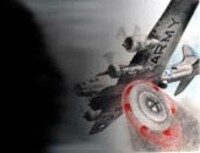
In Magnetic Field II it was invulnerable.
It then homed onto an Allied aircraft but did nothing.
The point was of course, that the craft was invulnerable in Magnetic Field II, but it worked both ways, and Allied aircraft were invulnerable to it.
In all probability, German scientists had not figured out at that stage how to get the foo-fighter out of Magnetic Field II into Magnetic Field I at altitude where it could explode alongside the Allied aircraft.
If this could have been achieved, the Reich would have regained air supremacy, for this was an anti-aircraft weapon with a 100% success rate at last - it would have exploded five meters from the aircraft fuselage giving the B-29 or Lancaster no chance of survival whatsoever.
Messerschmitt Me-271bz "Blitz Zerstörer"
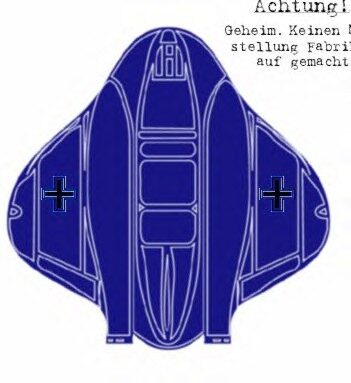
Drawings of a German World War II secret fighter project, referred to in classified Bundesarchiv records as the Geheimes Jagdflugzeug Me-271bz, have recently been discovered.
This aircraft was discoid in shape, and it is uncertain whether a prototype, flying or otherwise, was ever actually built by the Messerschmitt Flugzeugwerke.
What is of more interest is that the lead engineer on this project was Hauptmann Immelman Stahl.
It is dated October 1943, and bears a remarkable resemblance to witness reports of "flying discs" of the late war years.
According to the report, the aircraft would be "invisible" to radars of the time.
It has also been asserted that the Germans had reverse-engineered Alien technology and that the Me-271bz [Blitz Zerstörer/ - Lightning Destroyer] was the product of that effort.
The craft bears a slight resemblance to depictions of the famed "Roswell" aircraft that crashed in New Mexico in July 1947 according to eyewitness accounts.
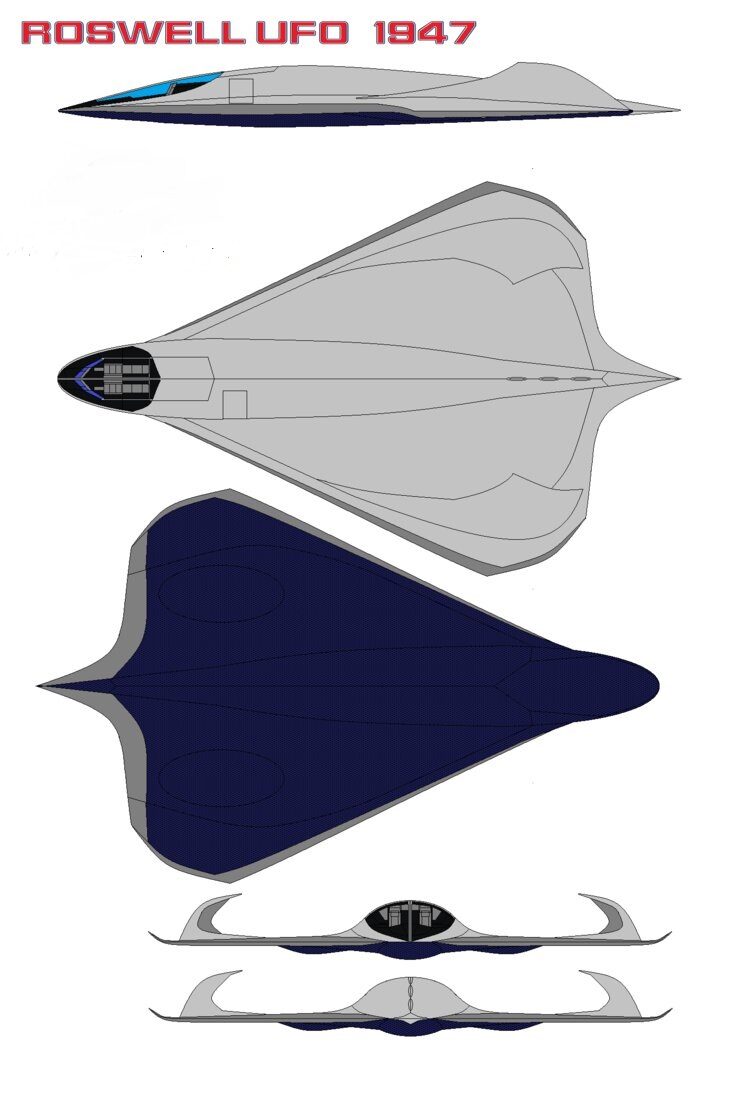
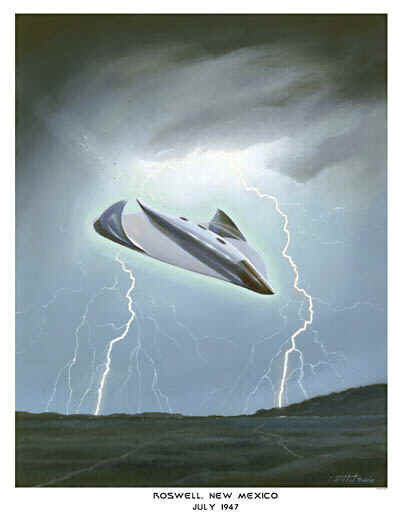 Reports of an alien spacecraft being struck by lightning and crashing late at night in early July 1947, near Roswell, New Mexico, were the beginnings of the most compelling event in all UFO lore.
Reports of an alien spacecraft being struck by lightning and crashing late at night in early July 1947, near Roswell, New Mexico, were the beginnings of the most compelling event in all UFO lore.
Originally reported in the "Fort Worth Star-Telegram" and confirmed by military officials as authentic, the report was later refuted by the military and the crash remains were claimed to be nothing more than a weather balloon.
Renowned aviation artist Tony Weddel has depicted the moments before the crash by capturing the object as an alien spacecraft in the initial stages of its death throes
In freefall, moments after being hit by a lightning upstroke, debris can already be seen in the slipstream.
Seconds later it would careen off the desert floor on the way to its final resting place.
Shedding debris from a fatal wound, its struggle for survival and the lives of seven Aliens purportedly ended 40 miles later when it slammed into the wall of an arroyo.
The unusual appearance of the UFO is based on various eyewitness accounts and other sources.
Regardless, the Me-271bz was a true stealth aircraft designed and possibly built when Germany was under round-the-clock Allied bombing.
From the modern depiction above it is hard to describe the craft except that it appears to have a wing shape possibly based on discoid types explored by both Messerschmitt and Dr. Alexander Lippisch at AVA Göttingen in the early 1940s.
The mysterious jet engines appear very similar to German-tested Lorin ramjets but there are no air intakes visible from the top side view.
There is a vertical tail to the rear and fuel tanks behind the cockpit, but how the pilot flew the craft is uncertain. The strange glass canopy/view port suggests that the pilot flew the craft in a prone position.
No armament is visible either but looking at the shape of the fuselage, the underbody was probably somewhat bulbous and could have featured a massive air inlet as well as twin or quad 30mm MK-108 installations supported a by tricycle landing gear.
Of significant interest is the blued aircraft itself, which is not painted.
If the aircraft was made of this strange blue alloy it is almost certainly a material pioneered by SS metallurgists called "Luftschwamm" [Aero-Sponge] that was a porous blue nickel-vanadium-and mix of other unknown metals. This would explain the lack of air intakes for the jets/ramjets - 'Luftschwamm' allows air to flow through the airframe.
Others insist the blue metal is an Alien type not found on this planet but manufactured/adapted by the Germans.
So who was Dr. Immelmann Stahl?
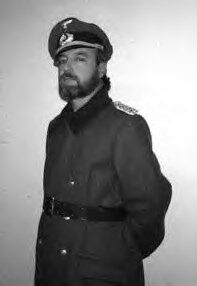
At the outbreak of war in 1939, Dr. Stahl was commissioned as an officer in the German Army and assigned to Dr. Wernher von Braun and his rocket development group at Peenemunde. In 1943, Dr. Stahl was assigned by special order to Operation 'Tannhäuser' at the Kiel Naval Base. His mission: tot develop radar invisibility for the German Navy. His career between 1940 and 1943 is largely a mystery.
At the end of the war, in May 1945, Dr. Stahl, along with other German scientists and intelligence personnel surrendered to US Army Intelligence to avoid capture by the Red Army. He came to the States in July 1945, and was immediately employed by the US War Department at the White Sands Test Range.
From 1949 to 1958, he worked for NACA, and from 1958 to 1979 for NASA. Although Dr. Stahl's official duty post was Cape Canaveral and the Johnson Space Center at Houston, Texas, he maintained another position at Aerodyne Labs, assuming full directorship there in 1980 upon his official retirement.
Upon questioning concerning the Me-271bz, Stahl refused to comment.
No doubt the Soviets would have tested the aircraft at NII VVS before sending it off to other test facilities.
Such a craft probably could not be duplicated in the USSR with Stalin’s hatred of copied German technology and his constant purges of aeronautical engineers whom he distrusted as academic enemies of the Communist ideal man. If the Me-271bz still exists, it is in storage somewhere - forgotten.
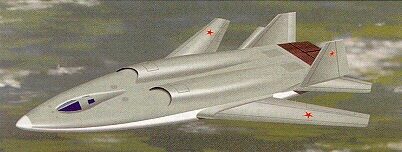 * as a footnote one should bear in mind that the Soviet secret T-60S bomber that has remained a secret for over 4 decades was immediately changed in the 1960s from a conventional type to some form of stealth craft that is similar in configuration to the Me-271bz but without the discoid wings.
* as a footnote one should bear in mind that the Soviet secret T-60S bomber that has remained a secret for over 4 decades was immediately changed in the 1960s from a conventional type to some form of stealth craft that is similar in configuration to the Me-271bz but without the discoid wings.
Air inlets on that design were moved to the top rear fuselage and the wings were altered to variable geometry.
Western military analysts have claimed the T-60S has been shelved, but the Russians insist that the project is still active.
Since the Germans involved with the Me-271bz fled to the West the captured prototype would have taken at least a decade to reverse-engineer… that is, unless the Germans got the material from an Alien intelligence.
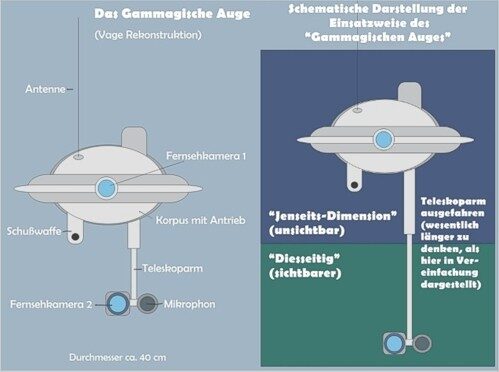
The Vril Gammagische Auge [Magic Eye] is a claimed Nazi espionage and reconnaissance device which was in the development stage in early 945.
Vril Gesellschaft Ing. Rolf Engel developed a miniature Vril Triebwerk [Thrustwork] EMG [Electro-Magnetic-Gravitic] engine and put it into a melon-shaped lightly armored body with a diameter of 40cm [1 foot 4 inches].
The body had a reception antenna, a central small television camera, a Schusswaffe, and a telescopic arm that held another miniature camera and a sound microphone.
By virtue of its design and connection to Vril, the magic eye would have the ability to emerge and submerge dimensionally - appearing and disappearing at will.
As such, this device was suitable for a wide range of military duties that included aerial recon, submarine protection, and especially espionage [foreign and domestic].
The advantage here was invisibility.
While the main body of the probe remained in the invisible part of inter-dimensional space, the telescopic sensor arm could lower its other camera and microphone into our dimension for spying.
The craft was so small that no factories were required to build it.
It was a cottage industry device, able to be assembled in a home, garage, apartment, barn, shed, etc… thus, no fear of Allied recovery of major documentation on the device.
Ease of assembly and disassembly would make it an ideal device.
By early 1945, Rolf Engel had performed lab tests with the power plant for this device and work was well underway on miniaturizing television equipment down from the bulky 1936 Nazi Olympics cameras to cameras that were just a few times larger than the post-war lipstick cameras of the 1960s.
Work on advanced television guidance for missiles had been perfected for the Hs-293D missile and for Mistel composite aircraft being developed by DFS.
The very small Argus As-292 target drone had by this time also been converted over to an RPV [Remotely Piloted Vehicle] equipped with small Zeiss optical and infra-red cameras in its small cylindrical body.
These went unnoticed by the Allies and none were shot down.
There is no evidence that a fully functional prototype was ever manufactured, but the basic flight characteristics of the small machine were probably tested.
The inter-dimensional aspects of the flying drone, however, are questionable.
On 3 January 1952, Brig. Gen. William M. Garland, Assistant for the Production of Intelligence, wrote a memorandum for General Samford:
SECRET
Contemplated Action to Determine the Nature and Origin of the Phenomena Connected with the Reports of Unusual Flying Objects.
This memorandum begins as follows:
1. The continued reports of unusual flying objects requires positive action to determine the nature and origin of the phenomena.
The action taken thus far has been designed to track down and evaluate reports from casual observers throughout the country.
Thus far, this action has produced results of doubtful value and the inconsistencies inherent in the nature of the reports has given neither positive nor negative proof of the claims.
2. It is logical to relate the reported sightings to the known development of aircraft, jet propulsion, rockets and range extension capabilities in Germany and the U.S.S.R.
In this connection, it is to be noted that certain developments by the Germans, pParticularly the Horten wing, jet propulsion, and refuelling, combined with their extensive employment of V-1 and V-2 weapons during World War II, lend credence to the possibility that the flying objects may be of German and Russian origin.
The developments mentioned above were contemplated and operational between 1941 and 1944 and subsequently fell into the hands of the Soviets at the end of the war.
There is evidence that the Germans were working on these projects as far back as 1931 to 1938.
Therefore, it may be assumed that the Germans had at least a 7 to 10 year lead over the United States in the development of rockets, jet engines and aircraft of the Horten-wing design.
The Air Corps developed refuelling experimentally as early as 1928, but did not develop operational capability until 1948.
3. In view of the above facts and the persistent reports of unusual flying objects over parts of the United States, particularly the east and west coast and in the vicinity of the atomic energy production and testing facilities it is apparent that positive action must be taken to determine the nature of the objects and, if possible, their origin.
Since it is a known fact that the Soviets did not detonate an atomic bomb prior to 1949, it is believed possible that the Soviets may have developed the German aircraft designs at an accelerated rate in order to have a suitable carrier for the delivery of weapons of mass destruction.
In other words, the Soviet may have a carrier without the weapons required while we have relatively superior weapons with relatively inferior carriers available.
If the Soviets should get the carrier and the weapon, combined with adequate defensive aircraft, they might surpass us technologically for a sufficient period of time to permit them to execute a decisive air campaign against the United States and her Allies.
The basic philosophy of the Soviets has been to surpass the western powers technologically and the Germans may have given them the opportunity.
4. In view of the facts outlined above it is considered mandatory that the Air Force take positive action at once to definitely determine the nature and, if possible, the origin of the reported unusual flying objects, taking the initial steps in this project during early January, 1952.
German Atomic Test
For some readers of history the very idea that Germany built and tested an atomic device during World War Two is heretical.
Conventional history has drilled it into our heads that American scientists of the Manhattan Project built the first atomic weapons.
They allegedly succeeded in accomplishing this goal in July of 1945 with the first atomic weapon was tested in New Mexico. Beginning in August of 1945, atomic weapons were dropped on Japan, which brought the Second World War to a close.
It is all very neat and tidy. American scientists became heroes, icons in our culture. Buildings and whole institutions are named after Enrico Fermi and Robert Oppenheimer, for instance.
At the same time we are told that the weak German effort at building atomic weapons was too little and too late and too disorganized.
Established history does not deny the German atomic program, it only minimizes it. Modern writers cite such evidence as the Farm Hall conversations as proof that the German scientists were years behind the Americans in building atomic weapons.
At the same time established history seeks to maximize the British effort to destroy the German heavy water producing facilities in central Norway. This operation is treated as one of the military/technological turning points in the war effort and one that sealed the fate of the German atomic weapons program permanently.
So that is it, then, neat and tidy?
Recently, new information has cast doubt on idea that the Germans were incompetent in this area.
This new information is based upon evidence in Europe itself rather than simply the controlled information released in post-war America.
Some of this new information is based upon exploration of underground facilities abandoned by the Germans in the closing days of the war. 1
Many of these underground facilities were sealed with explosives as the Germans retreated and never re-opened until after the collapse of the former Soviet Union.
Some of this new information is based upon research done in Germany at the Jonas Valley which indicates that a whole atomic infra-structure was set up there during and that this was done after the destruction of the heavy water facilities in Norway. 2
This is not conjecture but based upon eyewitness evidence as well as actual physical evidence which is still on-site. Some of this new information resides in the American government's own declassified words in which they admit the existence of neutron generators, for instance 3 and affix the location and scientists involved.
And finally, some of the new information comes from interconnecting a number of separated and isolated eyewitness and historical sources 4 which would have been impossible only a few years ago.
The resulting tableau painted by these facts is shocking, to say the least. What emerges is a detailed step-by-step, date-by-date account of the German atomic program.
Actually, it is many programs, not three or even six. Some were secret programs within a secretive Germany, one of these being run by the SS.
Thanks to this new research, we have dates, locations, names of scientists who were involved and even the weapons they produced at these individual locations. The Germans did make atomic bombs.
Not only did they make atomic bombs, they made Uranium as well as Plutonium bombs and other atomic weapons which remain somewhat of a mystery.
What the Germans could not do in these dying days of the 3rd Reich, was to match up one of these nuclear warheads with an effective delivery system.
The reasons for this differ with each weapon, individually, and run the gambit from mistake to treachery to incompetence. 4
The shocking outcome of these events was that the unexploded German atomic bombs fell into the hands of the Americans at the end of the war in Europe in May of 1945, two months before the "first" explosion of an atomic weapon in the New Mexico desert. What a present for the Americans.
All they did was to put new tail fins on the bombs, repaint them, and drop them on Japan.
Naturally, the American scientists involved with the Manhattan Project were given credit. 4
As an aside, the fact is that many of those very scientists were spies for the Soviet Union during this time as recently discovered Soviet Intelligence proves. 5.
And not just simple middlemen like the Rosenbergs, but those very icons in our society who speak for American atomic scientists, the ones ones who found a "conscience" after they realized the atomic bomb would never be used on Germany, as they hoped, but might instead be used on the Soviets after the war was over.
"Emigre", "Peacenik" scientists calling for and "end to war" - those scientists who posed, smoking a pipe, as someone somehow smarter and morally on a higher plane than everyone else.
Here are the facts:
"Calibre" was the Soviet code-name for their agent Greenglass.
"Editor" was their name for Enrico Fermi and "Star" was the Soviet code-name for their agent Robert Oppenheimer. 5
These men are our cultural heroes. Put your hand behind your ear. Can you hear the KGB laughing all the way from Moscow?
Not only were they spies, they conspired to lie about their work and did so. But they are not alone. They got a lot of help from their friends in the Intelligence community and the mass media.
The amazing truth is that they got away with the whole big lie. The Manhattan Project scientists, failures, unable to build their own atomic bomb, literally fell into the toilet and came out smelling like roses, as far as history is concerned.
Those interested in the whole story of the German atomic project can see the sources below.
There is a story of an eyewitness to a German atomic test which took place in October of 1944, nine months before "history" says that was possible.
This report originates in the journal "Defensa", Number 76-77, August- September of 1984. The text was in Italian but a summary and translation appeared in German language and it is from this translation that this report is derived. 6
The report was the life experience of the writer, Luigi Romersa. Mr. Romersa was sent upon a strange mission by Bonito Mussolini, the Fascist leader of Italy and Hitler's Ally.
The time was April of 1944. The war was not going well for the Axis Powers and Mussolini was summoned to a meeting with Hitler at Castle Klessheim, near Salzburg, Austria.
The meeting lasted three days. With Mussolini came Marshal Rodolfo Graziani and with Hitler were von Ribbentrop, Keitel, Dollmann and Ambassador Rahn.
Hitler's Allies had not been given little information on the development of German wonder weapons until this time.
This meeting was the first time Hitler had broached the subject with Mussolini.
Hitler and Mussolini were genuine friends.
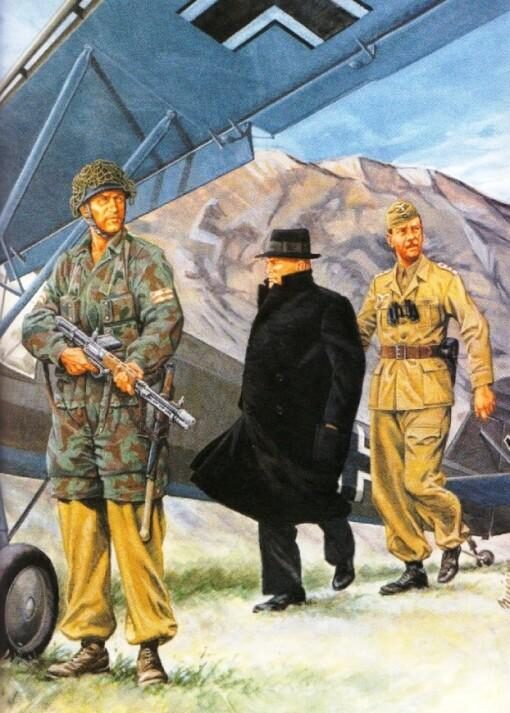
In the past, Hitler had personally defended Mussolini when he was disparaged by ranking members of the German military.
In Sptember 1943, Hitler intervened when the Italian government having deposed Mussolini, imprisoned him in a mountain-top fortress while entering into negotiations to turn him over to the Allies.
This intervention took the form of Colonel Otto Skorzeny, who led a team of commando raiders onto this mountain-top fortress in a daring glider attack.
El Duce was freed and flown to Vienna before the turn-coat Italian government knew what had happened.
Mussolini was subsequently installed in a Northern Italian government, loyal to Hitler.
Mussolini spoke excellent German and had even given a speech or two in that language.
Thus, it was not lack of trust or lack of communication, which caused the doubt that had arisen in Mussolini's mind after hearing Hitler's discussion of German wonder weapons.
But Mussolini did want to know if Hitler's promised weapons could really win the war.
In other words, he wanted to do his own appraisal.
The first meeting lasted two hours.
By all accounts, Hitler was the master of positive thinking and was also the master of intoning such optimism in the face of adversity.
Using this manner, Hitler reviewed the global political and military situation and inundated his guests with impressions and observations.
He assured his audience that the war would certainly be won once Germany had deployed its new weapons.
Hitler walked through the room as he said:
"We have aircraft, imperceptible U-Boats, giant tanks, cannons, unbelievably powerful rockets and a bomb with a force which will surprise the whole world.
"The enemy knows this, he attacks us, he destroys us... this destruction will be answered with attack..... and without launching biological warfare, for which we are also prepared. [...].
"All my words correspond with the purest truth which will be confirmed".
"Nazis with biological weapons" sounds like the "bad guys" in some sci-fi video game, but it is a thing that almost existed.
Germany's biologists during WWII actually figured out how to make all sorts of bioweapons.
The fact that they did not use any is all thanks to one individual who single-handedly threw a wrench in this Nazi super-plot - Adolf Hitler.
In 1943, a high-ranking Nazi scientist had recommended: "America must be attacked simultaneously with various human and animal epidemic pathogens as well as plant pests".
And they could have done it: The Nazis had already carried out a series of bizarre insect-related tests. at one point even toying with the idea of releasing up to 40 million weaponized potato beetles over England's crops.
The scientists also learned how to weaponize a many of human diseases, including typhoid, cholera, and anthrax.
The ingenious synthetic medium they invented to keep the diseases dangerous for weeks was considered an "outstanding" achievement by the American scientists who raided Nazi laboratories after the war.
So why did they not they use these "weapons"?
Early in the war, Hitler issued an obscure order that said there could be no offensive biological weapons research. Nazi scientists basically ignored that order and did it anyway, but Hitler refused to change his mind when he was informed that he now had WMDs.
Theories about why he did that abound.
After the meeting Mussolini quietly returned to Gargnaro, on Lake Garda in Northern Italy, where he had a residence. Mussolini clearly wanted to know more.
In the Fall of 1944, Mr. Romersa was summoned by Mussolini to the villa Orsoline where he was living with his family. Romersa was given the assignment by Mussolini to journey to Germany and find out more about things which had only been presented to him superficially at Castle Klessheim. Mussolini wanted detailed information.
Romersa was given credentials and a letter of recommendation for Göbbels and Hitler, respectively. Romersa traveled to Germany by car. Hitler personally read the letter of recommendation in his headquarters at Rastenburg in East Prussia and allowed Mr. Romersa's presence at some experiments.
He began his tour with underground factories that were concentrated in Upper Selesia and Bavaria.
The underground factories were more like small cities buried underground within a mountain. Elevators offered access the inner bowels of these well camouflaged, well-guarded facilities. The tunnels ran kilometer after kilometer within the earth, all connected by rail, which facilitated transport of personnel as well as material.
The tour of the underground facilities, however interesting, was not the highlight of Mr. Romersa's trip to Germany.
Sometime during the night of 11 October 1944 Mr. Romesa was picked up at the hotel Adlon in Berlin. He was told that after this particular trip, he would be received by none other than Minister Göbbels himself.
Mr. Romersa asked where he was being taken but to his question there was no answer. This was at two o'clock in the morning. A light rain fell that night as he was driven to his goal. At ten o'clock the following morning they arrived and got out of the car. They were on the shores of the Baltic in the vicinity of Stralsund. They took a motorboat from there to the island of Rügen.
Rügen was within the testing range were many German weapons were completed. This was a secret place, guarded by specialized units. It was an area in which none could even set foot without an approval card from the supreme command of the German military. In fact, Rügen Island lies just north of Peenemünde.
Once on Rügen Island, they immediately went into a region that was sheltered by trees. In a flat area within this forest there had been prepared stone houses and a protective Bunker made from cement. They went into a half buried underground tower through a metal door that was closed behind them.
Besides Mr. Romersa, there were three other men in the party. One of the military men who had accompanied Romersa began talking. He said that they would now witness a test of an atomic bomb. Nothing could withstand the blast of such a bomb, the man went on, saying that the explosive power of this bomb was the strongest ever discovered.
They were only a kilometer from the point of the explosion but, of course, well sheltered from the blast, which was scheduled for noon. Nevertheless, they would have to remain in the Bunker until that evening.
Romersa was told that the bomb released deadly radiation. The effective circumference of the blast would be a kilometer and a half. The witnesses would, therefore not only be seeing the blast, they would be experiencing it first hand. The telephone rang. The test had been moved up to 11:45 A.M.
Slits in the side of the concrete Bunker had been provided which were covered with smoked glass for viewing. Romersa could see trees and a darkened landscape. The telephone ran again with the exact time of detonation. All present synchronized their wrist-watches. Suddenly a blinding light appeared as the concrete tower of the Bunker shook.
As Mr. Romersa watched, a thick curtain of smoke descended over the landscape and then the cloud covered their position.
Nobody spoke. They were entangled in the smoke and the impact of the blast. They felt as if they had fallen over an abyss.
Finally, the driver of their vehicle who was a lieutenant in the army, the branch of the service that had prepared this test, said that the test they had seen and therefore confirmed was extremely important. When ready, he went on, these bombs could be dropped on the Anglo-American invasion troops or on enemy cities.
This bomb, he said, should cause the enemy to think twice about the course of this war.
The officer went on:
"We have done research for years. After long and tiring experimentation, we have finally completed this discovery. We have facilities everywhere. Some were met with and destroyed by the enemy, such as the facilities in Norway, but Peenemünde is intact although the Americans have sought to destroy this facility.
"In six or seven months the series mass production of these bombs will begin. Everything will change then but some will be perplexed or disconcerted because of or on account of the introduction of this frightful remedy".
Mr. Romersa continues his narrative which is loosely translated here:
"About four o'clock, the hall dark, there appeared some shadows. They ran to our Bunker tower. They were soldiers dressed in what looked like some sort of strange diving suit. These soldiers soon entered the building. They brought with them special garments for those inside to wear as they left the shelter of the Bunker".
Romersa did not know for sure what the overcoats were made of but they were white, rough fiber-like material that might have been asbestos. The head covering was provided with a slit of mica-like glass at eye level. They were given high but very light boots to wear as well as gloves made from the same material as the overcoats.
The soldiers led them out of the Bunker tower in single file.
The farther they got from the Bunker the more mixed up the landscape looked. The forest looked like it had been swamped by a wave of fire. In this burnt-out setting, Mr. Romera's foot struck something unusual. It turned out to be the carbonized body of a goat. The stone houses and tower that he had seen a few hours earlier were completely swept away.
The devastation increased as they moved toward ground zero. Here, the grass had a strange color resembling chamois and the trees that had remained upright were stripped of their leaves. They returned to Berlin that night.
Before the end of October Mr. Romersa met with Minister Göbbels. The meeting took place at Göbbels home.
Göbbels was informed of Mr. Romersa's presence at the "Experiment in Rügen".
He told Mr. Romersa that by various means great numbers of these weapons would be manufactured by which the enemy would be "decisively met with".
Countermeasures to the weapon, if any, could be thought up later since, by that time, this war would be over.
Göbbels paused and then began discussing delivery systems.
He told Mr. Romersa that the bombs would be delivered by special U-Boats equipped with Snorkels and turbines, from radio controlled V-weapons of unbelievable high speed, from supersonic aircraft, from long-range rockets, A-4 and A-9 with a range of more than one thousand kilometers.
"For a few months we must bear our teeth and hold out", Göbbles said.
"We need time. Twenty-four hours could be decisive".
Göbbels began to discuss the development of the atomic bomb. He mentioned that heavy water facilities were located in Norway as well as on the North-eastern coast of Germany.
The Allies knew of these facilities and their meaning. Air attacks and sabotage had been mounted, the latter being successful in Norway but not in Germany.
Hitler, according to Göbbels, had not wanted to employ atomic bombs at first because he thought them unnecessary to win the war.
In 1942, he changed his mind and inquired as to how long such weapons would take to develop. He was told it would be two years, which he considered too long. He changed his mind again in 1943 at which time intensive work began anew.
Göbbels described other weapons, confirming what Romersa had been told earlier.
These included new cannons, and instruments that would allow the Germans to see and precisely shoot in the dark. A dozen new remotely controlled rockets were in the works.
A-4 and A-9 rockets were to be equipped with 10 and 15 ton atomic warheads respectively.
Then Göbbels came back to a recurring theme. This theme was the need to hold out until these weapons became operational. He reiterated that six months were necessary. This contest was clearly a war of time since the Allies were dropping tons of bombs, day and night, in the hope that Germany would collapse in the meantime.
Göbbel's final words to Romesa were: "Germany's salvation depends upon its genius".
What can be made of Mr. Romersa's narrative?
The Germans clearly wanted Mr. Romersa to recount his impressions of the atomic test and the optimistic words he had heard to Benito Mussolini. But by late 1944, Mussolini was not in any real position to assist Germany at this point in the war. German atomic weapons were never deployed.
The German atomic programs were discredited by the Allies. Nobody had ever mentioned a German atomic test. One wonders what would have happened to anybody making such a claim in the early days of the cold war.
In light of these developments, Mr. Romersa's extra-ordinary experience on Rügen Island became a politically incorrect "tale" or at best a baseless "war story".
Without confirmation, it is no wonder that he kept the information to himself for so many years.
But Luigi Romersa, himself, did not fall off the pages of history. After the war, somehow, perhaps because of his substantial insider information concerning the Axis Powers, Romersa applied for and was granted a high security clearance with the government of the United States of America. 7
He went on in 1959 to write a ten part series, titled: "Wernher von Braun Y La America Del Futuro" [Wernher von Braun and the Future of America] for a Spanish language newspaper in Valencia, "Las Provincias". 8
One photograph contained within that series of articles shows the two men, Romersa and von Braun, standing together as von Braun points to a rocket model. One can only wonder what these two men discussed in their private moments.
Rügen Island is located at the tip of the peninsula where Peenemünde was located. Both were privy to insider information, which could have changed the popular world-view of the history of science and technology. They must have had a lot to discuss. It was only years later, in 1984, after von Braun's death, that Rmersa went public with the atomic test on Rügen Island.
Sources:
1. Jesensky, Milos, Ph.D., and Robert Lesniakiewicz, 1998, "Wunderland" Mimozemske Technologie Treti Rise, AOS Publishing, Czech Republic
2. Faeth, Harald, 1998, "1945-Thüringens Manhattan Project Auf der Spurensuche nach der verlorenen V-Waffen-Fabrik in Deutschlands Untergrund", CTT-Verlag und Druckerei Foester, Schleusingen, Germany
3. Combined Intelligence Objectives Subcommittee Evaluation Report 174, 9 July 1945, C.H.F. Müller, A.G. Hamburg, Fuhlsbüttel, Röntgenstrasse 24, Target No. CAFT 1/132a
4. Georg, Friedrich, 2000, "Hitlers Siegeswaffen Band 1: Luftwaffe und Marine Geheim Nuklearwaffen des Dritten Reiches und ihre Trägersysteme, Anum Verlag, Schleusingen and Heinrich-Jung-Verlagsgesellschaft, Gmbh, Zella-hehlis
5. Jesensky, Milos, Ph.D. and Robert Lesniakiewicz, 1998
6. Romersa, Luigi, German language translation of article in "Defensa", Number 76- 77, August-September, 1984, 'Gestern Nachricht, Heute Geschichte Die 'Geheimwaffen' von Hitler, etwas mehr als [nur]) Phantasie,
[English translation of the German title is: Yesterday's News Today's History The Secret Weapons of Hitler, something more than only Fantasy]
7. Mayer, Edgar and Thomas Mehner, 2002, "Die Atombombe und das Dritte Reich Das Geheimnis des Dreiecks Armstadt-Wechmar-Ohrdruf", Jochen Kopp Verlag, Rottenburg
8. ibid
La Fusee Pilotee "T"
This tale comes via a French researcher, Joseph Altairac. It is an article from the magazine "Au dela du del". The date is unknown.
This article was translated into English by the writer, editor, environmentalist, activist and free energy advocate, Remy Chavilier.
It much to do with the discussion of the German atomic tests and also concerns the subject of unknown large German rockets.
This article may be a confirmation of the atomic test seen by Mr. Romersa but if that is so it is seen through different eyes, which add some additional detail.
Also, the focus is different because this story is primarily about the rocket or flying craft sent to deliver the bomb.
This article clams that the device was the Triebflügel.
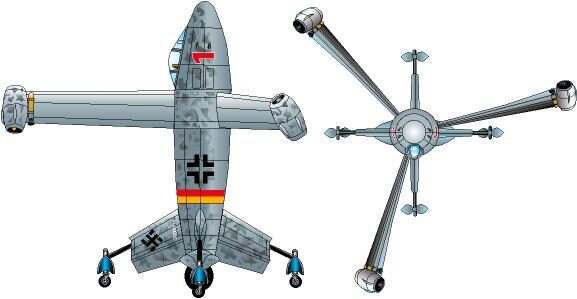
Focke-Wulf Triebflügel
By Rob Arndt
The origin of the Focke-Wulf Triebflügel started in 1938 with a patent application by Siemens engineer Otto Muck who proposed a VTO [Vertical Take-Off] aircraft.
Intrigued by Muck's concept, Kurt Tank of the Focke-Wulf Flugzeugbau decided to develop the idea with a coleopter designed in September 1944 by Dr. Ing. Heinz von Halem.
It was submitted as Focke-Wulf's fighter/interceptor proposal.
This tail-sitting coleopter was considered ideal for point defense operations, needing nothing more than a clear area for take-off, even from dense urban centers.
VTO was achieved through the use of three un-tapered wing-rotors that held Pabst ramjets at their tips.
Since ramjets do not operate at low speed it was intended to install a Walter liquid-fuelled rocket unit in each ramjet core or as an alternative fit jettisonable Walter 109-501 RATO units to the fuselage for launch.
To achieve this VTO, the wing-rotors were tilted to the +3 degrees angle.
The wing-rotors were located roughly a third of the way down from the nose and caused no torque problems with the fuselage.
Once 300 km/hr was achieved the ramjets ran on their own and the pilot, sitting in the cockpit near the nose, gradually tilted the wing-rotors through to 90 degrees, transitioning from vertical flight to horizontal flight using the vertical launch thrust for lifting thrust.
Increases in rpms and tilting of the wings were to be used for increased maneuverability at speed.
Control was achieved by use of control surfaces at the trailing edges of the tail fins.
Once in combat the Triebflügel was armed with two 30mm MK-103 cannon with 100 rounds each and two 20mm MG-151 cannon with 250 rounds each - all located beneath the pilot.
The most hazardous part of the Triebflügel's mission was not combat.
It was transitional flight with the return vertical descent being of most danger since the pilot's vision was obstructed by the spinning wing-rotors and the exhaust halo surrounding the craft.
The landing gear consisted of four retractable tail fin pods and one fuselage pod that contained the wheels for VTOL.
The Triebflügel held promise but unfortunately the project was cancelled along with all other design projects that could not produce an emergency aircraft within 60 days.
Only the Bachem Ba-349 'Natter' [Viper] VTO point defense interceptor made the cut but never made it into action.
A scale model of the Triebflügel was tested in an aerodynamic wind tunnel and reached Mach 0.9.
Post-war, the victorious Allies made use of the tail-sitter interceptor with the Convair XFY-1 Pogo and Lockheed XFV-1 Salmon X-planes.
Technical Data:
Crew: Pilot only
Powerplants: 3x Pabst ramjets, each of 2,000 lb thrust augmented by three undetermined Walter liquid fuel rocket motors or two standard German Walter 109-501 RATO units of 3,306 lb thrust each
Wing-Rotor diameter: 38 ft
Overall Length: 30 ft
Weight loaded: 5,200 lb
Max. Speed: 621 mph est.
Armament: 2x 30mm MK-103 + 2x 20mm MG-151
The Triebflügel was an aircraft shaped very much like the V-2 but with three wings at its center and rotating around the craft like a helicopter. At the end of each rotor was a ram jet.
The three ram jets powered the craft which could rise vertically and then transition into horizontal flight. There was no rocket exhaust at the tail of the craft as in the V-2.
In fact, the resemblance to the V-2 was superficial. The Triebflügel was an interceptor. It was never intended to be used to deliver a bomb.
Further, only models of the Triebflügel, no full-scale versions actually flew. What all this means is that, this device's designation as a Triebflügel is almost certainly wrong.
There were manned rockets under consideration by the Germans and this could have been any one of those prototypes. The list includes the A-9, the V-1, and the Sänger stratospheric vehicle. It may have even been some sort of hybrid machine, a manned A-4b for instance, which was a V-2 with large wings, intended to glide to its target rather than free-fall.
The article begins stating that this rocket delivery system exists but without giving it a name or other designation.
The test occurred in Northern Germany just as in the Romersa description. In the heather of that region a target town was erected with concrete buildings, low cost houses, two and three-storey buildings, offices and metallic constructions. Different types of cars were parked on the streets.
There was a small train station, rail tracks, locomotives, gardens and winding trees added a to complete the picture of a town. Two miles away from the town a shelter was constructed from which to observe the test. In that shelter there were Luftwaffe technicians and army officers.
The article says that "witnesses" saw "the rocket" rise vertically. The three flaming engines could be plainly seen.
The missile leveled off at 8,000 meters and flew in a rather zig-zagging manner toward the target. Nearing the target the missile seems to have made a wide turn, under power, which could be heard by the witnesses below.
The power was then cut and the missile started downward. At 5,000 meters the transparent nose broke away and the pilot bailed out. A few seconds later his white cloth parachute could be seen slowly descending in the vicinity of the shelter.
"The rocket landed almost in the center of the buildings with a deafening detonation. There was a huge flame and everything was covered with a dense, gray heavy smoke, while a warm breath cutting puff of air spread rapidly. It took more than one hour for this dense curtain to clear.
From the buildings, only debris remained. Metallic constructions stuck out of the ground shapeless and melted. The tall trees were no more than burned trunks.
At the point of impact, the ground was literally furrowed with deep crevasses, actually burning in some points and dug as if subjected to an enormous pressure.
The cars parked in the street were reduced to debris, or violently thrust by the explosion against the houses on fire. The concrete train station had partly collapsed.
The locomotives had resisted the blow but the smashed and tipped over wagons showed their insides".
The article goes on to say that a great number of French prisoners witnessed these rockets in the hands of the Germans and being destroyed prior to the Allied advance.
"The Germans went to great length to hide these experiments. The Allied information services found out about them only after the peace was declared, and competent technicians thought it was a nuclear explosion".
The article goes on to describe what they believed to be the facts of the rocket used to deliver the weapon, the Triebflügel.
One obvious shortcoming of using this device as a bomber is mentioned:
"It is to be noted at this point that the weakest part of what our witnesses relates lies in the fact that, according to a few American technicians, the explosions were of a nuclear kind.
"In which case, the pilot being ejected near the launching place would make no sense at all because of the harmful radiations of the bomb which would have had a considerable effect thousands of meters away".
Here it is stated a second time.
The bomb was nuclear or considered such by the investigating American technicians.
It is to be noted that the real dangers of atomic radiation were only appreciated much later, not in the 1940s, or 1950s, but only later did the real enduring nature of atomic radiation sink home in the minds of most individuals.
This story would be considered just another post-war tale if it were not for some of the other evidence offered here and by the investigators working in the area of the German atomic bomb.
The validity of the German atomic bomb and exactly how this story meshes with the tale of Mr. Romersa will be left for the reader to decide.
Source: 'La Fusee Pilotee "T", an article from Au dela du ciel [magazine], 1958, author unknown.
Mysterious German Bombs
A few fragmentary accounts are explored which deal with truly strange bombs on which the Germans were said to be working.
There are sporadic accounts of a German bomb, which is sometimes said to kill all life within its blast radius.
The interesting thing about this bomb it is alleged to do this by absorbing all the oxygen within this area.
The first report shown here from late 1943 is typical in that it gives few details. It says only that the projectile in question contains phosphorus and other chemicals that absorb oxygen within a radius of a few hundred meters from the spot of detonation.
The second report referenced "Nordhausen", the site of the huge underground V-1 and V-2 rocket production facility, adds some detail to our picture of the oxygen bomb.
This report says that the bomb has been under development for three years and it is huge.
The dimensions given are: Length 17 meters [about 55 feet] with a diameter of 7 meters [almost 23 feet].
This would make it larger than a V-3 rocket.Its kill-zone is said to be several kilometers.
The third report of this device is marked "Polish Intelligence".
It repeats the active ingredient as phosphorus compounds and then goes on to say that the radius of action of this bomb is larger than present incendiaries. The facts that the bomb itself was very large and that its killing radius was also very large are worthy of note.
Details are lacking but this same basic theme has come from different sources.
The next very strange bomb is the endothermic bomb or cold bomb. Like the oxygen bomb, little reports of this device crop up throughout the wartime Intelligence reports. In the "Polish Intelligence" report we learn that it works though some unknown chemical agent. The chemical agent is disbursed by the bomb, evaporates, and the result is a sudden drop in temperature for the area within the bomb's working range.
Freezing kills life forms. Some property damage also results such as the breaking of water pipes and some cables. Some confirmation of this device comes from another intelligence report on a related weapon, "icing gas".
As is known from recent airliner crashes, an airplane wing does not work well when it is iced over. Airports work long and hard with dedicated crews and special chemicals to keep aircraft wings free of ice before take off.
According to the report, the Germans wanted to use ice to down Allied aircraft.
They planned to send a aircraft, or even a robot aircraft, ahead of a flight of a bomber squadron and discharge this specific chemical. The chemical would drift back, ice over the bomber's wings and cause them to fall from the sky. The substance forming the active ingredient was called 'Azote' which was a mixture of liquid nitrogen [minus 250 degrees C] and liquid air.
We know the Germans were making liquid air projectiles shells for cannons. Air is largely nitrogen, so it is not surprising that a chemical cocktail wasn't being considered by the Germans for use as a bomb.
The last item in the 'Polish Intelligence' document, is a very brief description of a third bomb. This is described as the H.B. bomb "of great power". This H.B. was to be used with the other two bombs for maximum efficiency. What was this H.B.?
Could it be a hydrogen bomb?
Perhaps the most mysterious bomb of the Second World War is called the molecular bomb or M-bomb. Indeed, a respected German researcher has told me that the account of Luigi Romersa as discussed above, was not exactly an atomic bomb in our modern conception of that device but a molecular bomb.
This bomb was said to have been under development through the combined efforts of Dr. Kurt Diebner and Manfred von Ardenne in addition to their work on a classic atomic bomb.
This is interesting because these are two very different, high-profile individuals.
Diebner was already involved in more than one atomic project and was also involved with a secret SS atomic project. So, in other words, Dr. Diebner was a somewhat clandestine scientist whose primary allegiance belonged to the SS and Dr. Kammler. It may be that he even reported the progress of these other projects in which he was involved directly to the SS.
Manfred von Ardenne ran one of the well-known German atomic projects. This was for the Reichspostamt, the German Post Office.
Now, in the USA, the Post Office is just about the last place you would want running a high-tech, crucial, war sensitive project but this was not so in wartime Germany. The German Post Office enjoyed a high-tech reputation and organization. It was perhaps on the same order as Bell Laboratories in the US.
Manfred von Ardenne was a first-rate scientist and had all he needed to do his work.
The M-bomb was developed in a middle school in Stadtilm but that no tests were carried out in Thuringia. 1
This bomb was in the widest sense an atomic weapon but very different from both the atomic and hydrogen bombs we are familiar with.
This bomb is also known as a super-compression bomb because it was composed of matter that was compressed or "densified'"as compared to normal matter.
This bomb did generate pressure and heat just as a normal atomic blast does but did not generated radioactive radiation. The discussion of super-compression, is reminiscent of the work of Karl Nowak.
Nowak was responsible for a process used to compress and so strengthen metals through cooling and pressure. He was also responsible for a new method of power generation within an internal combustion engine in which a super-cooled liquid gas was injected and subsequently expanded, producing power. 2
Did the M-bomb have any relationship to the oxygen bomb or the cold bomb? Unfortunately, the answers still await exact determination.
Finally, there was yet another type of liquid air bomb. This information comes to us via British Intelligence Objectives Sub-Committee report 142, which is a gold mine. 3
In 1944 the progress on the atomic bomb was not as advanced as the Germans expected. It was decided at that it was time to experiment with a kind of "Ersatz" bomb using liquid air and coal dust.
Dr. Mario Zippermayr was put in charge of this project and the first tests were done at the Döberitz grounds near Berlin.
A mixture of 60% finely powdered dry brown coal was hand-mixed into a 40% solution of liquid air. Eight kg of powder was mixed together for this test.
This was actually done by a man named 'Krautsfeld' according to the report, by hand, using a wooden stirrer. According to Krautsfeld, the witness for the report, an area whose radius was 500 to 600 meters containing trees was absolutely destroyed.
The explosion started to rise into the air, afterward, so that only the tops of the trees were affected, although the explosion itself consumed 2 km. At this point Dr. Zippermayr had the idea that a better effect might be realized if the powder was spread out in the form of a cloud before the explosion.
Sources:
1. Georg, Friedrich and Thomas Mehner, 2004, "Atomziel New York Geheime Grossraketen-und Raumfahrtprojekte des Dritten Reiches", Jochen Kopp Verlag, Rottenburg
2. Nowak, Karl, Deutsches Patentamt, Patentschrift Number 905847, original patent dates from 16 March 1943
3. British Intelligence Subcommittee report number 142, pages 4 and 5, London
"Projekt Hexenkessel" The Fuel-Air Bomb
The German word "Hexenkessel" means "witches cauldron" in English.
It is only one of the projects run by a true genius of the days of the Second World War, Dr. Mario Zippermayr, born an Italian of Austrian parents and educated in German speaking institutions.
His interests ranged from perfecting color photographic film to the medical benefits of ozone therapy. He is remembered for his wide-ranging weapons research.
His involvement with secret weaponry has never been much of a mystery but the true nature of his research has been hidden in layers of secrecy and disinformation until quite recently.
As the war broke out, Dr. Zippermayr was drafted into the Luftwaffe but detailed to begin practical research to facilitate the German effort.
Dr. Zippermayr was first posted in Vienna and given his own laboratory where he headed a thirty-five man research team.
Among some of the research objectives he was given at this time were the development of the L-40 torpedo, the development of the "Enzian" and "Schmetterling" anti-aircraft rockets as well as the development of a mysterious, high-speed jet airplane.
Suddenly, in March of 1945, Dr. Zippermayr was put in charge of a facility called 'Talstation', near Lofer.
The acronym T.A.L. means Technische Akademie der Luftwaffe. The word "Tal" also means "valley" in English.
Talstation, which was actually more than one facility, was located in the mountainous region of the Tyrol, approximately where Germany, Switzerland, Austria and Italy meet.
Dr. Zippermayr and his pre-existing staff, now a total of eighty individuals, set up shop in one of the outlying sub-bases just outside of Lofer which was called "Hochtal" [high valley].
Dr. Zippermayr continued his brief tenure at Lofer until 8 May 1945, the day of the German surrender.
Days later, American troops reported the presence of 2,000 kilos of explosives at Hochtal and laboratory facilities in an absolutely pristine state.
Dr. Zippermayr continued to reside at Hochtal, setting up an open house for any Intelligence people or dignitaries who cared to visit.
On 15 May 1945 Dr. Zippermayr was arrested and interrogated by military authorities. Shortly thereafter he was discharged from the Luftwaffe with the rank of Major and transported back to Lofer on 20 June 1945 where he apparently continued to host the "open house".
The facility was visited by increasingly higher levels of Intelligence people, including Colonel Leslie E. Simon, Director of the Ballistic Research Laboratory at the Aberdeen Proving Grounds. Dr. Zippermayr complied completely with all requests for information.
Information used for this report does not come from a review of the existing literature on Dr. Zippermayr or his work. Instead, it comes as a result of a Freedom Of Information request directed to the United States Army regarding Dr. Zippermayr and the facility at Lofer.
The Army responded with a whole series of reports, each originally more classified than the last, which gave a whole new perspective on Dr. Zippermayr and his work as well as the nature of the maintenance of secrecy concerning German secret weapons.
The Army even persuaded the Air Force to contribute with a report of their own which was known to the Army but now out of their control. In all four large reports were received.
Legend and propaganda had it that Dr. Zippermayr was working on a "Vortex Cannon" at Lofer.
It was said that this gun was powered by coal dust and set off in such a way that a huge explosive vortex would be generated. This explosive vortex was said to be powerful enough to blow the wings off enemy aircraft and so was to be employed as an anti-aircraft weapon. Hidden within this story is an element of truth.
But the truth is much greater than the alleged story, so much greater that it can only be concluded that the whole vortex cannon concept was created to conceal the nature of this truth. It is unclear if the Germans originally concocted this tale and it was just maintained by the Americans or if it was completely a post-war addition by the Americans.
Vortex Gun
This is a portion of a U.S. government post-war interview with Dr. Mario Zippermayr, 8 March 1949.
In this interview Dr. Zippermayr explained to the U.S. officials the test conclusions he reached during the war blowing coal dust out of hollow pipes.
This test method led to a cover story that Dt. Zippermayr had invented a "vortex cannon" by which enemy aircraft would be swept from the sky.
This myth still persists to this day and has even been repeated by a prominent and respected historian in a recent British TV documentary.
The Vortex Gun was basically a mortar barrel of a large caliber sunk in the ground, and the shells contained coal-dust and a slow-burning explosive in the center.
The first experiments with compressed air were failures.
The shells, once fired, were intended to have the function of creating an artificial whirlwind or tornado which would hopefully make enemy airplanes lose control and thus knock them out of the sky.
If all circumstances were perfect and favorable, the strange device seemed to work fairly well. Numerous high-speed films were taken and processed for analysis and study, which concluded that the rotation and forward-moving explosion of the coal dust was in fact able to start the formation of a fairly large vortex.
Although it was unknown whether the pressure changes of the tornado would be strong enough to cause frame failure in aircraft caught in the air current, it was known that the pressure on wing loading might be excessive.
In the years before this invention, it was known that clear-air tubulence had brought down large airliners and broken them into pieces.
It seemed possible and feasible that Dr. Zimmermayr's unlikely-sounding cannon could have the same effects too. In fact the gun would be cheaper than but as effective as shells filled with high explosive. The range of the prototype was estimated to be about 100m, even though the gun was never used in practice.
The initial explosion scattering and vaporizing the coal dust must be slow enough to allow a long billowing explosion over a wide area. For this a mathematician was included to verify Dr. Zippermayr's work.
Other than this math, the method was so simple and direct that a cover story was needed lest this cheap rival to the atomic bomb fall into the wrong hands.
This cover story and strategy worked for decades.
When Dr. Zippermayr began his experimentation on coal dust the project was code-named "Humus".
On 8 March 1945, in the waning days of the war, the project was re-named "Hexenkessel". At this time, coinciding with Dr. Zippermayr move to Lofer, a large-scale, intensive effort was put into this project, involving several agencies besides the Zippermayr laboratory.
Coal contains a surprising number of calories, that is, it has a high energy content even when compared with the explosives of the times.
As a matter of fact the amount of energy available in coal is about five times that of high explosive.
But to get the highest possible temperatures and pressure from the explosion, it must be an instantaneous detonation. The destructive effects of this explosion are limited by the intensity and duration of the explosive pressure.
Explosive pressure at the center produces high heat but at the same time the very nature of the explosion disperses the explosive material eventually to a point were detonation no longer takes place, so limiting the scope of the explosion. But it was found that the effectiveness on an explosion upon a target with flat surface was more dependent upon increased duration of the explosion rather than high intensity.
Knowing this, Dr. Zippermayr concentrated upon producing explosions of longer duration. Coal dust is explosive within a confined space, every coal miner knows this, but to get coal dust to explode in the atmosphere it has to be compressed. The wave of air pressure resulting from an explosion can provide this compression.
It was found that this could be done using by packing coal dust around a low velocity explosive charge but not directly next to it. A space between the charge and the coal dust was necessary for dispersion of the coal dust into the atmosphere. Under pressure from this explosive wave, the coal dust of the fuel-air bomb mixes with the atmosphere and uses atmospheric oxygen as its burning agent rather than chemical oxygen in the warhead itself.
To defend a city against a close formation of bombers, used at that time, several smaller explosions would be used at once.
The rockets "Schmetterling" and "Enzian" were foreseen for this purpose.
Multiple rockets would detonate, spreading their coal dust packages in a large area throughout the atmosphere directly below or above the bomber formation. All the warheads would be detonated at once by radio. A truly monstrous explosion would take place near the squadron, producing a long duration explosion that would simply break the wings off the heavily laden bombers.
Tests had begun with coal dust being shot out of tubes pointed upward. Something curious was observed. A flaming vortex was observed which spread outward from the center of the column of air as it was shot skyward. From this curiosity was born the cover story of the "Vortex Cannon".
In fact, what was being developed was what we call an air-fuel bomb today. The blast resulting from this kind of weapon is second only to an atomic bomb in destructive power.
According to a later set of declassified documents received under pressure from the Army, Dr. Zippermayr met with U.S. Air Force officials on 18 March 1949.
Dr. Zippermayr presented his findings to the Air Force for the use of what would be called the air-fuel bomb for use as an anti-aircraft weapon.
The record of this meeting is important because he explained the explosive process in somewhat more detail.
According to the report:
"...He explained how the column of coal dust vapor was ignited at the bottom, how the vapor was forced by the counter-pressure of the outside air into a series of vortices, and how the first explosion initiated a chain-reaction of increasingly powerful after-explosions".
Unlike conventional explosives, he declared, coal-dust vapor had an explosive effect on areas rather than points. As a result, he theorized, the pressure could be used preferably for the destruction of large objects, but would, by changing the atmospheric conditions in a comparatively wide space, stop-and possibly destroy-aircraft in flight.
Coal dust explosions of sufficient magnitude, he maintained, should compare with the area effect of atomic bomb explosions, and would be infinitely cheaper.
He expressed his belief that rockets loaded with coal dust could, like atomic bombs, be carried by aircraft to their destination, and could be launched with destructive effect on cities or other installations. If necessary, other fuels could be substituted for coal dust; gasoline, for instance, would constitute a powerful explosive if it were used under appropriate conditions".
Three points taken from the general FOIA text on Dr. Zippermayr are worth mentioning at this point.
Coal dust or any solid fuel once it is blown into the atmosphere in this way becomes a vapor. This long-duration explosion characteristic of the fuel-air bomb actually seems to be many explosions, each billowing out and creating the next.
According to Dr. Zippermayr such an explosion would probably reach a maximum height of one mile.
At the conclusion of the meeting it was recommended that Dr. Zippermayr be hired along with a mathematician for further work. That was 1949.
The fuel-air bomb concept was not spoken of publicly by the government until the United States was ready to invade Iraq during the Gulf War.

At that time much was made out of the possibility that Saddam Hussein might possess a fuel-air bomb and use it on U.S. ground troops.
Presumably, the technology was known outside the USA.
Perhaps this presumed leak came during Dr. Zippermayr's weeks at the "open house" in Lofer when anybody might have simply inquired about this technology.
In any event, the Iraqis did not use a fuel-air bomb in the early 1990s.
Again, this idea was to sleep for a period of time.
According to recent chatter on the Internet, the fuel-air bomb idea has been recently resurrected, now going by the name "a-neutronic bomb" or "electrohydrodynamic gaseous fuel device".
This bomb is said to be the handiwork of the renegade scientist Dr. Michael Ricionoscuito.
Dr. Ricionoscuito is also remembered for his other work, the famous "Promis" software, used to spy on individuals by just about every government intelligence agency in the world today.
The a-neutronic bomb consists of blowing a cloud of gaseous, combustible material into the atmosphere.
A small rocket, launched into its midst trailing a small wire connected to the ground, charges the cloud with electric energy so that the cloud is saturated with electro-static energy.
The cloud is detonated and the resulting explosion being on a par with a small atomic detonation.
The resulting blast also produces the same long duration as its ancestor. This is evidenced by the fact that it is said that the Nevada test site, which is flat desert, sank about 30 feet after the blast.
Sources:
- Combined Intelligence Objectives Subcommittee Evaluation Report 201, 7/23/45, Report On Talstation, Lofer, Target Nos. C-4/222 and C-1/667, obtained through Department Of The Army, Fort George G. Meade, MD. 20755-5995
- Counter Intelligence Corps, Salzburg Detachment, United States Forces Austria, Zell am See Section, 8/4/45, Case Nol S/Z/55, Zippermayr Mario Dr. Ing., obtained through Department Of The Army, Fort George G. Meade, MD. 20755- 5995
- Headquarters Seventh Army, C.I.C. Detachment, 5/16/45, Dr. Zippermayr, [Stabsingenieur] Kreis Zell Am See, Lofer, obtained through Deptartment Of The Army, Fort George G. Meade, MD. 20755-5995 - Combined Intelligence Objectives Subcommittee Evaluation Report 201, 7/23/45, Report On Talsation, Lofer, Target Nos. C-4/222 and C-l/667, [Expanded Version], obtained through Department Of The Army, Fort George G. Meade, MD. 20755-5995
- Conference of CWS Officials with Ing. Mario Zippermayer, Regraded Unclassified, 7/13/99 by USAINSCOM FOI/PA, obtained through Department Of The Army, Fort George G. Meade, MD. 20755-5995
'Pfeil'" [Arrow] Aircraft
In reviewing the new documents sent by the Army concerning Dr. Zippermayr it became evident that he was involved in another project, which had never been reported before.
This project was called the "Pfeil Flugzeug" or Arrow aircraft. This "Pfeil" had nothing to do with the Dornier project of the same name.
Anyone familiar with German weaponry of the Second World War knows how much research has been done in tracking down every proposed German aircraft prototype.
These prototypes have been fleshed out in illustrations and in projected operational data by interested researchers. These illustrations fill numerous books and magazines as well as several Internet web-sites dedicated to the idea of what might have been if the 3rd Reich had lasted another year.
Because of the intensity of this work and the number of years that it has been in progress, it is truly gratifying to stumble upon something new and unreported at this late date.
The concept for this aircraft came from his work on another project, the L-40 aerial torpedo. Dr. Zippermayr's solution to the problem of the aerial torpedo led directly to a subsequent project, the Pfeil aircraft.
The standard German aerial torpedo was released at about 50 meters [slightly over 150 feet] from the ocean's surface by an aircraft in horizontal flight at an air speed of about 300 km. per hour or about 180 m.p.h.
To release higher or faster would cause the torpedo to impact the water at too great a speed, damaging the torpedo's steering mechanisms.
The Germans suffered substantial losses to their attacking aircraft using these weapons and tactics. The low altitude and low speed simply left the attacking aircraft vulnerable. What was needed was a new torpedo with a new attack methodology.
The Germans needed a torpedo that could be fired from a distance, at a high altitude, and at jet-plane speeds. They wanted the new torpedo to be launched at 1.5 kilometers from the target, at any height, at any angle and at speeds up to 700 km per hour [435 m.p.h.]
Dr. Zippermayr reworked the internal components of the new aerial torpedo with these goals in mind. But what is most interesting were his aerodynamic solutions for the new torpedo.
This solution was a new gliding surface that automatically balanced the torpedo in flight.
This gliding surface was a new wing with a special shape. It was attached to the top edge of the torpedo and its wings were "V" shaped as seen from the front or rear. This wing design automatically confirmed stability on the flying craft since its center of gravity was directly below what we might call its point of suspension, the midpoint between the V-wing surfaces.
Tests were performed in which the torpedo was dropped from an aircraft flying at speeds up to 720kph and from heights of over 1000 meters. The Arado 234 was envisioned as using this weapon.
The work was carried out from January, 1944 until the end of the war.
The success of the L-40 torpedo design had obvious implications for high-speed aircraft. Besides Dr. Zippermayr, Messerschmitt, Augsburg, was already present at Lofer for work on the 'Enzian' rocket.
Dr. Wurster and none other than Dr. Lippisch worked on this project. Given all this aviation genius, it is no surprise that the Aerodynamische Institut der Technischer Hochschule, Hanover was put to work conducting wind tunnel and other tests of the torpedo design. They passed the opinion that the structure was sound and suitable and could be applied successfully to aircraft.
These findings were published in their technical research manuals [Berichten des General-Luftzeugmeister].
Orders were given to Dr. Zippermayr to incorporate the torpedo principles in developing a jet-propelled aircraft capable of extremely high speed.
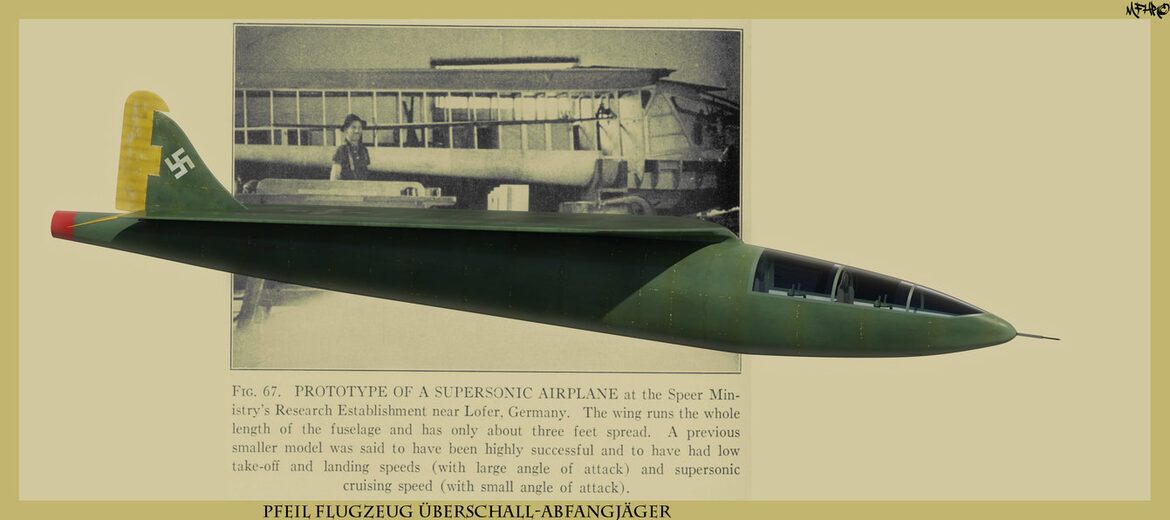
The first aircraft was to be a high-speed fighter. But, at the same time experiments were to be conducted to determine the value of the new design in the construction of gigantic, high-speed airliners. These plans were said to have been successful as far as they were able to progress before Germany's defeat
The first step was to build a model glider, complete with instruments to register flying and diving qualities of the aircraft.
This model would be released from a tow line at high altitude.
The results of these experiments were then used in the construction of the first full-scale glider model.
It was during the construction of this full-sized model, about three-fourths complete, that the war ended and construction stopped.
At least for a time the model was stored at the Hagen carpenter shop in Lofer.
After flight tests of the full-scale model were completed, work was to begin on a jet-propelled prototype.
The Army report states:
"Dr. Porsche, located at Schuttgut near Zell-am-See had already been assigned the task of supplying the jet-units".
Yes, this is the same Dr Porsche whose cars we all know and love.
The Zippermayr wing design had two advantages over contemporary wing design.
The first was tremendous speed.
Even as the Army wrote up their findings, in July of 1945, two years before the sound barrier would be officially broken, there was already discussion in the report of this wing design going supersonic.
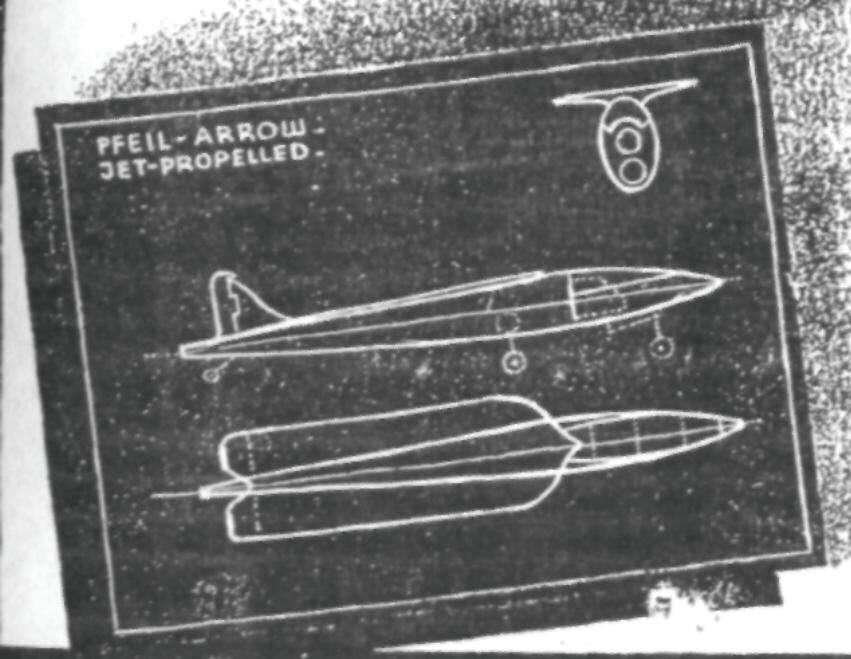
Blohm & Voss P.203.
This wing design is called a scissor wing. At takeoff the wing assumes its customary position, at right angles to the fuselage.
After take-off, when high speed is desired, the wing is rotated from the standard position to a position almost parallelling the fuselage.
At high speed, this position would still provide enough lift for flight yet the atmospheric drag would be greatly reduced as in the Zippermayr design.
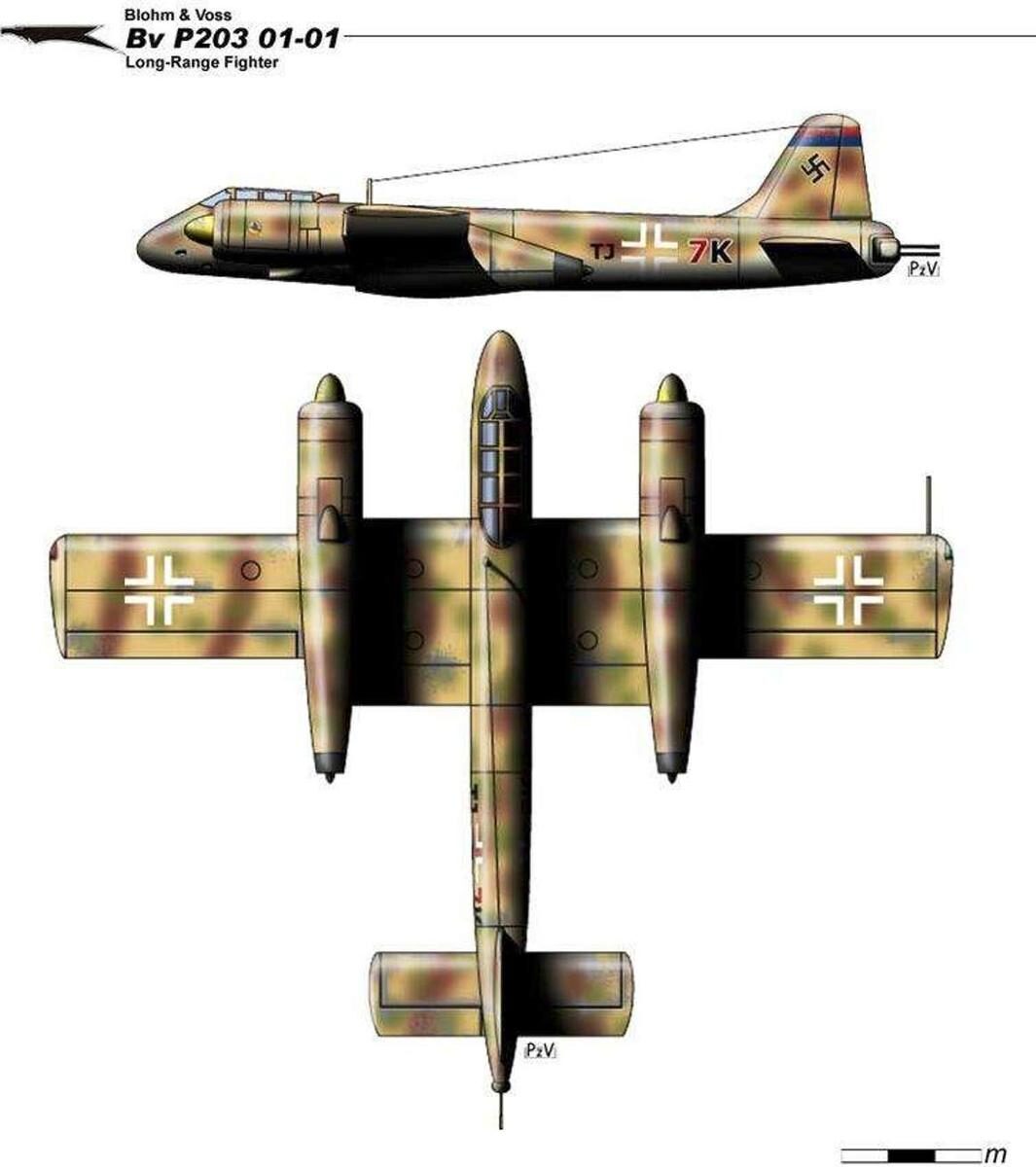
The scissor wing design would combine the virtues of a standard wing, for take-off and low speed efficiency, with the reduced wind resistance of the Zippermayr design for high-speed performance.
The government documents do not make this connection, nor does any known literature to date, but the similarity of the two designs begs for comparison and possible connection.
The scissor wing has remained on the drawing board in spite of its apparent advantages.
Every so often mention of this design or a picture of a futuristic aircraft with scissor wings appears on the cover of a magazine.
Sources:
- Combined Intelligence Objectives Subcommittee Evaluation Report 201, 7/23/45, Report On Talstation, Lofer, Target Nos. C-4/222 and C-1/667, obtained through Department Of The Army, Fort George G. Meade, MD. 20755-5995
- Counter Intelligence Corps, Salzburg Detachment, United States Forces Austria, Zell am See Section, 8/4/45, Case Nol S/Z/55, Zippermayr Mario Dr. Ing., obtained through Department Of The Army, Fort George G. Meade, MD. 20755- 5995 120
- Headquarters Seventh Army, C.I.C. Detachment, 5/16/45, Dr. Zippermayr, [Stabsingenieur] Kreis Zell Am See, Lofer, obtained through Department Of The Army Fort George G. Meade, MD. 20755-5995
- Combined Intelligence Objectives Subcommittee Evaluation Report 201, 7/23/45, Report On Talsation, Lofer, Target Nos. C-4/222 and C-1/667, [Expanded Version], obtained through Department Of The Army, Fort George G. Meade, MD. 20755-5995
- Conference of CWS Officials with Ing. Mario Zippermayr, Regraded Unclassified, 7/13/99 by USAINSCOM FOI/PA, obtained through Department Of The Army, Fort George G. Meade, MD. 20755-5995
Hitler's Pub Dart Bomb: The secret Nazi weapon drawn up to terrorize Britain
By Daily Mail Reporter
11 December 2008
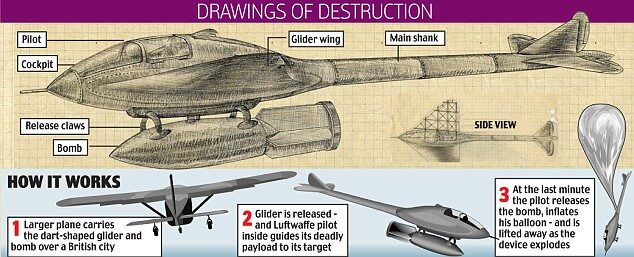
The drawings for the "Silent Dart" were found in the Reich Chancellery in Berlin.
Towards the end of the war Hitler became increasingly desperate to find 'weapons of terror' which he could use against the Allies
With deadly accuracy and at speeds of up to 700mph, it could have pinpointed Nazi targets and wreaked havoc on Britain.
At least, that is what German scientists believed as they plotted this weapon of terror.
Hitler became increasingly desperate for a way to thwart his enemies at the end of the Second World War.
And so the Nazis dreamed up the "Silent Dart".
The glider would be released from a larger aircraft. Guided by a Luftwaffe pilot inside, the dart would dive towards the ground carrying its 1,000kg bomb.
At the last moment, the pilot would release the bomb and inflate a huge balloon attached to the craft.
As the bomb hit its target, the balloon was supposed to whisk the glider far up above the danger area, so it could travel to safety.
The plans, which have come to light more than 60 years after their creation, may sound implausible - but pencil drawings of the dart found by the Allies in July 1945 show that for the Nazis, it may have seemed a real possibility
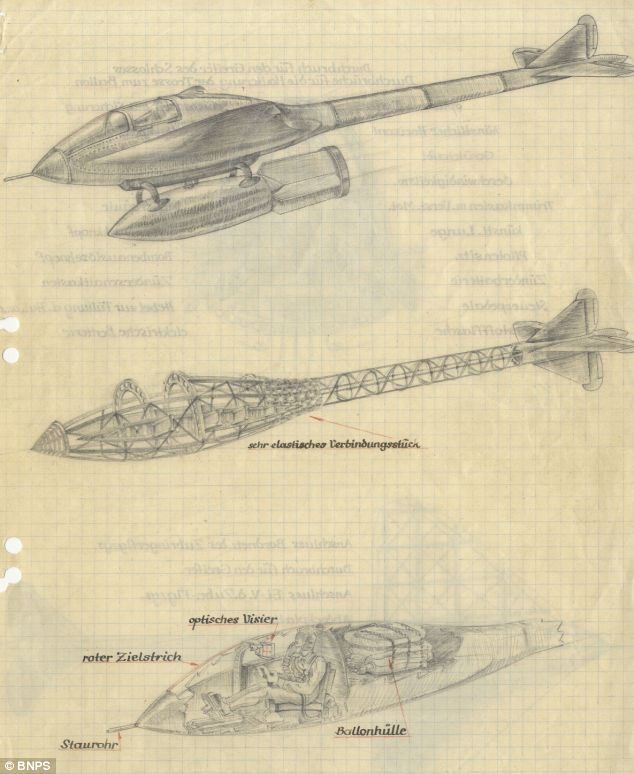
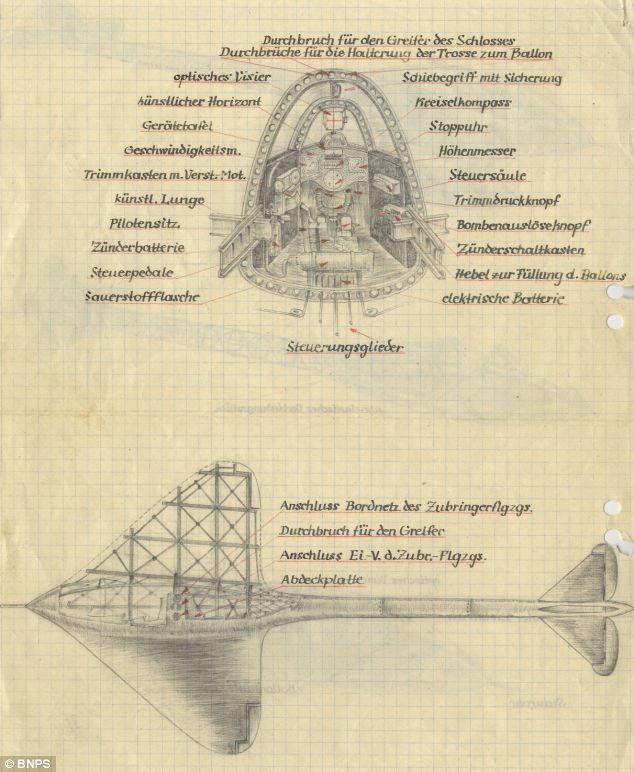
These previously unseen drawings were rescued from
Hitler's Chancellery at the end of World War II.
The glider carrying the bomb has been designed in the shape of a pub dart.
The drawings are undated but go into detail about how the cockpit should be
constructed and where the various instruments should sit.
Auctioneer Richard Davie, who is selling the sketches, said:
"There is no date on the plans so we don't know whether they were not acted upon because there was no time, or whether there was another reason.
"The glider would have used the flying principle of a pub dart. It would be released from a mother ship and then directed by a pilot, which is not a job I would want.
"Then as the pilot released the bomb a balloon would simultaneously inflate and this would add stability and elevation to the glider.
"This enabled the pilot to get away from the blast so he could make safety and then have another go - unlike a Kamikaze pilot.
"It would have worked a bit like a Kamikaze mission but without the death of the pilot.
"The designs were found at the Reich Chancellery, in Berlin, at the end of the war and have rarely been seen since".
The drawings were discovered by Richard Rex, who had been sent to Germany to help establish a medical dispensary for use during the Potsdam Conference.
The conference had been convened to decide how defeated Germany was to be governed in the post-war world.
They belonged to his family and were then sold to a private collector who is in turn selling them, "International Autograph Auctions" explained.
Retired Air Commodore Graham Pitchfork, who is an aviation historian, said:
"Towards the end of the war a lot of highly unusual projects were developed by the Nazis.
"However implausible this might appear to us, German scientists were renowned for their resourcefulness and invention.
"While this sounds an implausible way of getting a bomb on target the Germans were increasingly desperate by the end of the war.
"They were desperate to find a terror weapon which is why they developed the V1, V2 and the V3".
The plans, which are thought to be worth between £2,000 and £3,000, will be sold in London on Saturday.
Large German Mystery Rockets "The Hammer of Thor"
By the term "Large German Mystery Rockets" what is meant are rockets larger than the V-1 or V-2 with which we are all familiar.
The first people to raise the possibility that the German ever built anything larger than the V-2 were Colonel Howard A. Buechner and Kapitän Wilhelm Bernhart in 1988. 1
Colonel Buechner was a U.S. Army medical doctor and later Professor of Medicine at Tulane University and Emeritus Professor of Medicine at Louisiana State University.
During the war, he was among the first Americans to enter Dachau concentration camp.
Kapitän Wilhelm Bernhart is an alias. The reason for the use of an alias is obvious as his resume is assessed.
Bernhart was a German officer who served aboard the famous U-530. U-530 surrendered, not in May of 1945 when the war in Europe ended, but on 10 July1945 at Mar del Plata, Argentina.
The nature of this U-Boat and its mission have been the subject of much speculation and controversy. Kapitän Bernhardt is now a U.S. citizen and has been engaged in commercial shipping for 32 years.
The nature of the V-2 controversy starts with its time frame. Dr. Wernher von Braun and his rocket team finished work on the V-2 in August of 1943. After that, the V-2 was taken to the vicinity of Nordhausen in Thuringia. There, in a vast underground factory, it was mass-produced.
The question is, what in the world occupied Dr. von Braun's time between August of 1943 and May of 1945 when he surrendered to the United States military?
It should be noted that a number of follow-up versions of the V-2 were envisioned by German engineers, and historians will continue to wonder how World War II would have played out if Germany had the time to develop these concepts, along with perhaps an atomic or biological weapons payload.
The German concept weapons carried the "A" designation, like the A-4 which eventually became known as the V-2. The A-5 actually preceded the A-4, and was used as an interim test prototype of the A-4.
The loss of launch sites in France and Belgium caused the Germans to test a winged version of the V-2 intended to increase the range of the missile. Called the A-4b, the missile was a V-2 outfitted with wings to allow a glide path to a more distant target.
The first A-4b prototype was test launched on 8 January 1945 but failed to meet its test objectives. A second A-4b prototype was launched on 24 January 1945. This missile validated the winged V-2 concept, and became the first winged missile to break the sound barrier. Although promising, A-4b missiles never went into production.
German concept vehicles considered to follow the V-2 began with the A-6.
Although design of the A-6 was completed, the vehicle was never built. The A-6 would have been identical to the V-2 with the exception of fuel. The A-6 would have used nitric-sulfuric acid as oxidizer and vinyl isobutyl ether mixed with aniline as fuel.
These fuels were storable, and were intended to quicken the speed and ease with which the weapons could be handled and launched. The same operational improvement was incorporated when the U.S. Air Force liquid-oxygen burning Titan I was replaced by the Titan II, which employed storable propellants.
The A-7 was a winged missile based upon the design of the A-5. Dummy versions of the A-7 were dropped from aircraft for the purpose of gathering ballistic flight data. Test versions of the A-7 were launched using a 3,500-pound thrust engine adapted from the A-5.
The A-7 was found to have a 30-mile glide path when launched from an aircraft flying at an altitude of five miles, or a 15-mile range when launched from the ground. The vehicle was intended for testing only, and was never deployed as a weapon. The A-8, which was never built, would have been a winged version of the A-6.
The A-9, similar in concept to the short-lived A-4b, was proposed to increase the range of the V-2 to 400 miles through the incorporation of wings. The wings would allow the A-9 to glide toward its target, rather than drop to the ground, at the end of its ballistic flight.
However, since the A-9 would have a greater range than the V-2, it would be required to glide toward its target at relatively low speeds. Like the V-1, the A-9 would have been relatively easy to intercept in flight. As a result, the A-9 was neither built nor tested.
An interesting application of the A-9 concept was a manned version of the A-9 employing a triangular landing gear. Had it been built, the manned A-9 could potentially have carried a pilot a distance of 400 miles in just 17 minutes.
The designation A-10 was given to what would have been the first stage of a missile employing the A-9 as a second stage. The A-10 stage would have been 65 feet long and had a diameter of 13 feet, 8 inches. It was designed to produce a 400,000-pound thrust by burning nitric acid and diesel oil.
Calculations indicated that the A-10 first stage coupled with an A-9 second stage could carry a 2,000-pound payload a distance of 2,500 miles. If built, this would have been the world's first intermediate-range ballistic missile.
But, the von Braun design team did not stop there, and indeed had plans on the drawing board that could have resulted in the first space launch vehicles. The designation A-11 was given to the first stage of a vehicle that would have employed an A-10 as second stage and an A-9 as third stage. The specific intention of von Braun was to carry a manned A-9 third stage into space.
The A-12 designation was given to a powerful first stage concept capable of producing a liftoff thrust of 2.5 million pounds.
The A-12 would have been mated to an A-11 second stage and an A-10 third stage. Calculations indicated that the total vehicle could have carried a 60,000-pound payload into space.
One must wonder what might have happened if World War II had turned out differently for Germany. The von Braun design team had laid the groundwork for the development of the world's first space launch vehicles even before the close of the war. It is likely that, given the time, Germany would have applied these concepts to the development of intercontinental ballistic missiles.
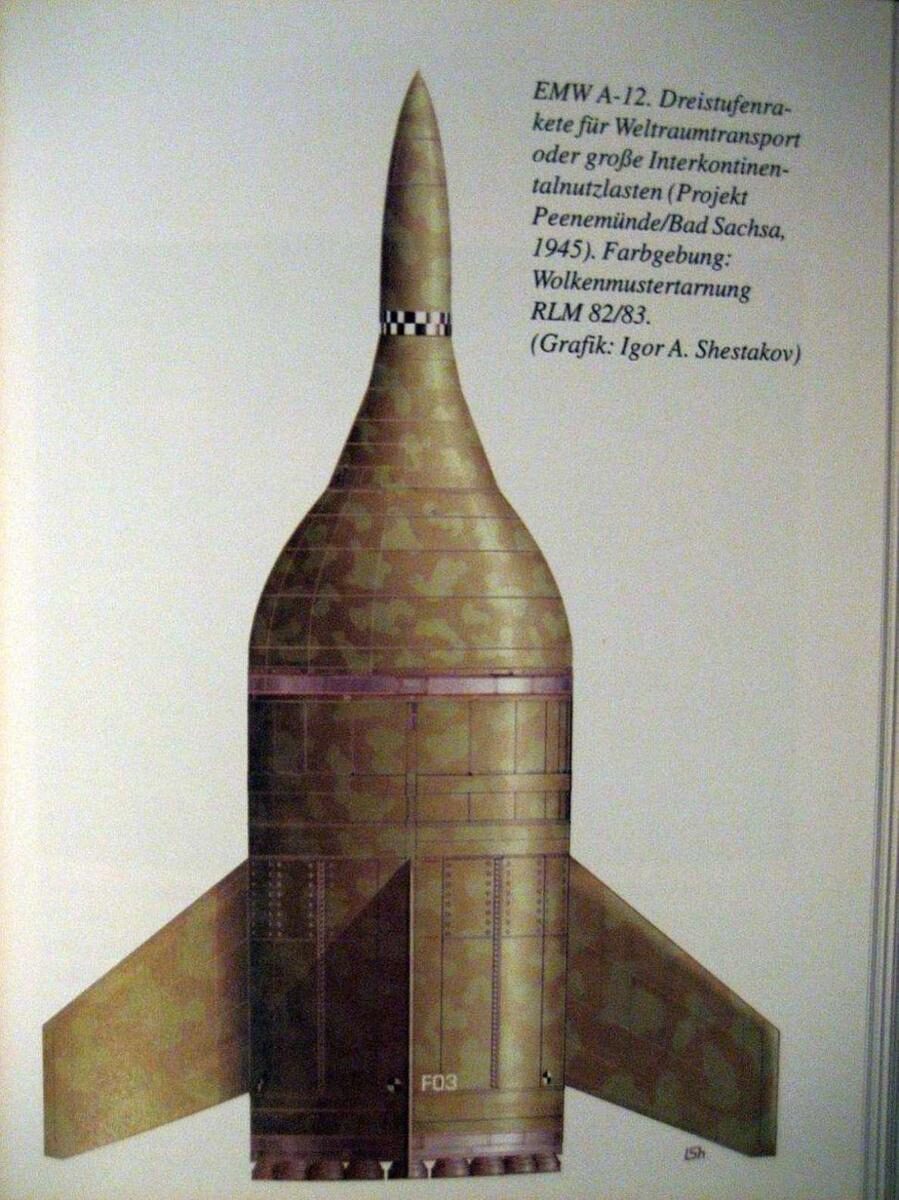
Here are the facts that we are told. It is a rocket.
It is 68 feet long. It was produced in small quantities.
It has a considerably larger warhead, larger payload, than the V-2.
What fits this description? The one thing that fits this description best is the first stage of the A-9/A-10.
The first stage of this project was never built according to official history.
The second stage, the A-9, looked like a somewhat modified V-2 [A-4] rocket with longer, swept-back wings.
Diagrams of the A-9/A-10 shows us that the A-10 was a short, stocky rocket whose upper half encased the A-9.
According to reliable sources, the A-9/A-10, together, stood 30 meters, about 90 feet, in height. 5 The A-9, the second stage, is 45 feet long.
If the first stage, the A- 10, is 68 feet long, the total length of the rocket would be 113 feet.
But the second stage A-9 is set inside the cowling of the A-10 with approximately only half of its surface showing.
Half of 45 is 22.5 feet.
If we add the correct figures together, 68 feet for the A-10 and 22.5 feet for the portion of the A-9, which can be seen, we get the figure of 90.5 feet.
This is a good approximation of the height of the combined A-9/A-10.
The 68-foot rocket described in the government report can not be a description of anything other than the A-10.
One more point.
The government Intelligence report says that these rockets "are known to exist".
This obviously means that they were built, not on paper, but in metal.
The government Intelligence report also says that they "may appear in small quantities during the year".
The government is not talking about capturing these rockets at this point in time.
The words "may appear" really means "may fly".
[For a description of the lift-off of the A-9/A-10, see the sources 3 and 4 listed below].
But if the A-10 was actually built, would not there be some sort of confirmation on the ground from the German rocket scientists themselves?
Of course there should be testimony concerning this but it seems that all the testimony was in the negative.
The German rocket scientists denied making rockets beyond the V-2.
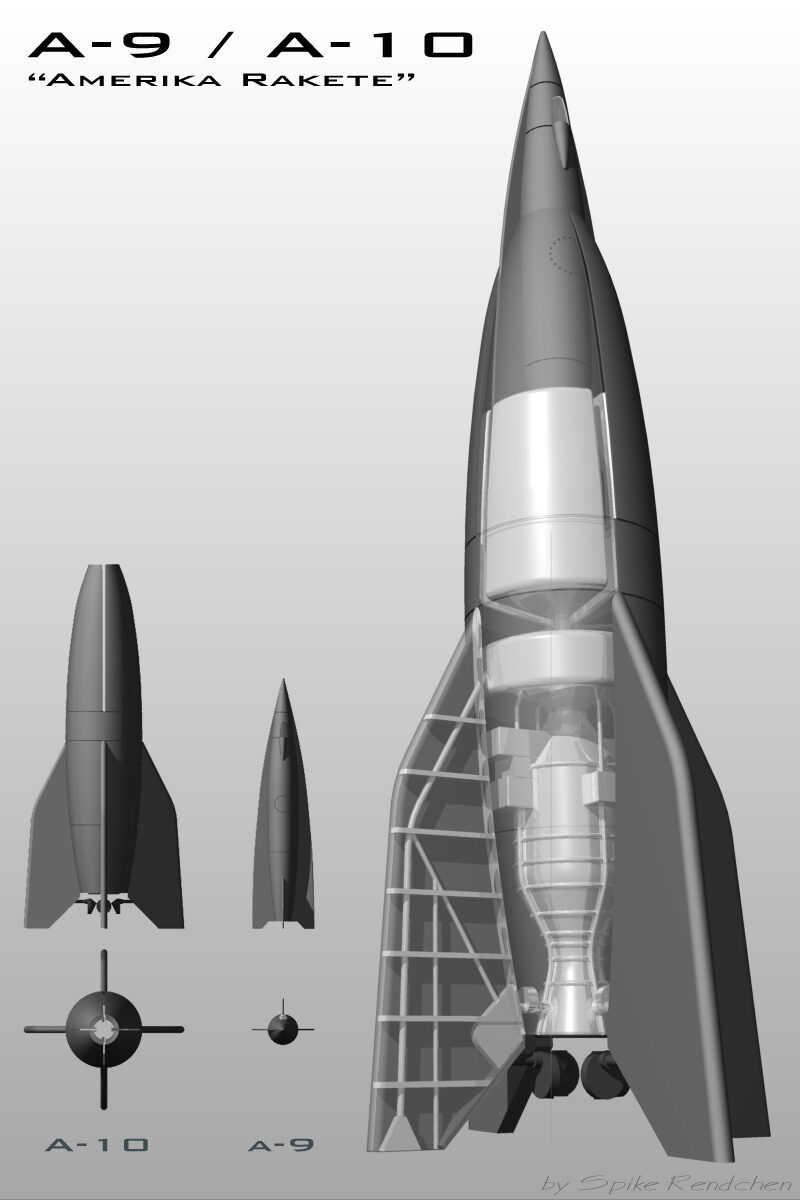
These German scientists were, however, under extreme pressure, pressure generated by the Cold War, to do and say exactly what their new employers and benefactors, the government of the United States of America, said they should say.
Most of these same scientists, for instance, denied that German flying discs were built during the war. This claim has now turned out to be completely false.
Time and research work have put a chink in this cold war propaganda armor. The question is if there is a chink regarding the A-10? Is there any German source that affirms its existence? Recently, such a source has been found.
Not only was such a German source found, it was heavily relied upon by the Intelligence agencies of the United States of America.
As with many sources within government itself, this one was found by accident, while researching something else. The topic in question then was the "V-3".
A "'V" weapon was purely a political designation. "V" stood for 'Vergeltung' which means 'vengeance', perhaps better expressed in the vernacular, 'payback'.
It seems there were several weapons on their way to being designated as the V-3.
A F.O.I.A. request was made concerning the V-3 since the name appeared in a government index.
The government's source was declassified in 1993 and it was a German prisoner of war who fell into the hands of the U.S. Seventh Army. 5
A date stamp indicates this was on or about 14 December 1944.
The prisoner was a disgruntled German who had tried to immigrate to Australia before the war but was drafted before this could take place.
He was made a paratrooper and later served as a field chemist.
He was caught listening to a BBC broadcast and as punishment he was sent to Peenemünde in March of 1943 and placed under the auspices of the Luftwaffe.
He was given work described as 'dangerous' to complete his punishment. He was later assigned to Nancy, France, where he deserted and contacted U.S. forces.
The information this prisoner provided on Peenemünde was quite wide-ranging, including descriptions of the hardware being developed there, personnel, maps, organizational information, and security information.
The prisoner described the V-3 as follows:
"V-3 This is a radio-controlled glider bomb launched by a HE 177 and is intended to be guided into enemy bomber formations. PW, who personally timed it, noted that it remained in the air seven minutes.
"When PW left PEENEMÜNDE in July 44 the bombs were not yet considered satisfactory sometimes dropping into the sea before the seven minutes had elapsed. He believes that this weapon may now have a higher number in the V series".
This little description is important because it will tie in with information about this missile developed from another source.
The big surprise coming from this F.O.I.A. request did not come from any disclosure concerning the V-3, however, but concerning something the prisoner described under another section - "V-2 Glider Bombs".
In this section the same prisoner describes two different types of V-2s. One is called the A-4 and is described as about 18 meters long and 2.5-3 meters in diameter.
This is the 45-foot V-2 with which we are familiar.
But there is a second rocket present. This one is called "Type A 1".
It is described as being about 23 meters long and 4.5 meters in diameter. Only the smaller, 18 meter V-2 was in mass production according to the report.
The prisoner states that V-2s have attained a height of 12-15 kilometers in altitude. At that altitude, 15 kilometers, its range is said to be 500 kilometer. This is long but otherwise not surprising.
What is surprising is that the prisoner says that he heard that technicians intended to launch "them" to an altitude of 120 kilometers, "which would have permitted them to reach NEW YORK."
The difference between 15 and 120 kilometers is considerable. Obviously, the difference is the difference between the two rockets under discussion with the higher altitude and range going to the larger rocket.
How big was this larger rocket? A 23-meter rocket is about 70 feet long.
Likewise, the diameter, 4.3 meters, corresponds to "about" the dimensions of the A-10 and the source, the prisoner, does use the word "about" in describing these dimensions.
The target discussed, New York City, indicates its range and this also corresponds to the A-10.
The name given it by the prisoner, is lumped together with the V-2, indicating that it was a second version of that weapon which was not yet in mass production. He calls it or it is called in this report "Type A 1". Note that there is no hyphen between.
From the description given, we can see that this "A-1" reference is a corruption of the A-10 or a censored deletion of the word by the U.S. Army so it would not surface in a search of records A and 1.
Considering the description in its totality, it can be argued that this "Type A 1" is a mistake or a typographical error or a deliberate deception—an attempt at a cover-up.
All this was done simply by omitting one zero. This rocket's true designation certainly should have been given as Type A-10.
This prisoner had no reason to lie.
His other information was mostly very accurate. There was no attempt on the part of the U.S. Intelligence to hedge his testimony [in case it proved false] as was their most common practice.
The U.S. Seventh Army believed it was getting the best information this particular individual could supply. - the A-10 was a reality but produced in limited quantity.
Sources:
1. Buechner, Howard A. Col. and Kapitan Wilhelm Bernhardt, 1989, "Hitler's Ashes", Thunderbird Press, Inc., Metairie, Louisiana
2. ibid
3. Mayer, Edgar and Thomas Mehner, 2002, "Die Atombombe und das Dritte Reich Das Geheimnis des Drieiecks Arnstadt-Wechmar-Ohrdruf", Jochen Kopp Verlag, Rottenburg
4. Georg, Friedrich, 2003, "Hitlers Siegeswaffen Band 2 Star Wars 1947" Band 2, Teil B, Amun-Verlag, Schleusingen
5. MU 500, CSDIC [WEST], SEVENTH ARMY APO 758 US ARMY, reference No. 579, PEENEMÜNDE EXPERIMENTAL CENTER [KARLSHAGEN], 14 December 1944, Declassified Authority NNO750122, 7/13/93
Note: There are two new books in German language describing in even more detail the reality of the A-10:
A. Georg, Friedrich, 2004, "Hitlers Siegeswaffen Band 2: Star Wars 1947 Teilband B: Von der Amerikarakete zur Orbitalstation-Deustschlands Streben nach interkontinentalwaffen und das erste Weltraumprogram", Amun-Verlag, Schleusingen
B. Georg, Friedrich and Thomas Mehner, 2004, "Atomziel New York Geheime Grossraketen-und Raumfahrtprojekte des Dritten Reiches", Jochen Kopp Verlag, Rottenburg 238
Yet Another "V-3" Rocket
As mentioned earlier, when one speaks of the "V-3" one never knows what the specific response will be. There have been so many weapons called by so many people the V-3.
Examples of these are the 'Hochdruckpumpe', the high pressure cannon, the Me-262 jet fighter/bomber, a further development of the Henschel HS-293 for purposes other than floating targets and various missiles and rockets under development by the Germans at the time.
This is about one of these latter rockets.
While the report described above did mention the V-3, a much better report came bundled up with various other reports under the heading of 'Werwolf'. 1 [There is just no figuring out the government's filing system].
The informant in this case was a prisoner of war, a Czech of German ancestry named Joseph Koch. Koch was an engineer who was assigned in May of 1944 to the Flottmannwerke in Breslau.
He worked there for three weeks before it was learned that he was a Czech, which, somehow, made him ineligible for continued employment at Flottmannwerke so he was returned to the Army.
During his three week stint at Flottmannwerke he had access, on about ten occasions, to the director's office. On the wall of that office was a diagram of a new rocket, which he overheard officials speak of as the "V-3".
Did the Czech engineer who stumble upon at least one of Dr. Hans Kammler's pet projects? Pehaps Kammler was building a second long range rocket or series of rockets in his eastern sphere of influence centered upon the Kammler Group Headquarters neat Pilsen/Prague.
Before describing Flottmannwerke or the V-3 more fully, the reader should be made aware of the unique circumstances of the plant's site itself, Breslau.
Breslau was a city in the German state of Silesia.
Silesia was the eastern-most state or Provence within the German Reich. Breslau was a large city in the west central part of Silesia that contained, for instance, a large governmental presence and a university.
Breslau and this entire Silesian region were also somewhat of a center in the German testing and development of secret weaponry.
As the Soviets pushed westward at the end of the war, Breslau became isolated. The Reich propaganda of the times called it "Fortress Breslau". In fact, it held against the Soviets surprisingly well.
Hitler Youth learned new defense tactics during the siege and formed a major component in the defense of Breslau. The Hitler Youth were so successful that some of their leaders were flown to Berlin to organize the defense of that city. In fact, Breslau held out against the Soviets longer than Berlin held out.
But today neither Silesia nor Breslau no longer exists. After the war all of Silesia was ceded to Poland and became part of that country. The Germans living in Breslau as well as the remainder of Silesia were all relocated west into the Soviet zone of East Germany.
The German population of Silesia and Breslau were entirely replaced, almost overnight by Poles. This movement of peoples brought with it a cultural disconnect.
Current residents of western Poland had no connection with the pre-war population whatsoever. Silesia and Breslau, like the American Confederacy after the Civil War, were "gone with the wind".
The point of this history review is that all happenings in Silesia during the war cannot be verified or traced in any meaningful manner. The German industrial plants are gone. The university is gone. The streets and the names of the cities themselves have been changed.
All we have of what happened there during the war came out of there on the backs and in the minds of the German refugees who were displaced. This report is, then, one of those scraps of evidence we have concerning this important region.
The Flottmannwerke consisted of thirteen buildings and a work force of 2,000 individuals working three shifts per day.
A railroad ran directly into the plant from which raw materials were unloaded and, presumable, from which finished weaponry was shipped to its point of insertion. A special police force enforced security and secrecy at the plant.
The Flottmannwerke made tank treads for German tanks and tracked vehicles but its highest priority work concerned making interior parts for V-weapons. Prefabricated hulls for these weapons were delivered by rail along with steel strips measuring 15 meters in length.
Shortages were experienced, according to Koch, concerning light metals necessary for finishing the weapons. Five or six V-1s had been assembled by May 1944 as well as 3 or 4 V-2s. Koch saw the diagram of the new V-3 weapon well enough to make a drawing of it and memorize some of its details.
He said it is intended to be a large rocket that functions on practically the same principle as a rifle grenade. From this description we might say today that this was a ballistic weapon.
The rocket itself was 33.1 meters long and 3.2 meters in diameter. These figures put the rocket in the neighborhood of 100 feet long and over 10 feet in diameter. Koch reports it had eight sections containing nitroglycerine and compressed air. This is somewhat confusing since we do not know if he is talking about rocket stages or construction modules.
The statement about nitroglycerine and compressed air is further confused by Koch's admission that he had no knowledge of the proposed method for starting the rocket in flight and "could not reveal any information regarding the force whereby it would be sustained in flight".
In other words, he did not know its method of propulsion.
Koch relayed what he termed "hearsay" on the subject that the new weapon was to be partially inserted into the end of an immense gun barrel, estimated to be 25 meters in length, from which the rocket was to be shot somewhat in the manner of a rifle grenade.
From Koch's description we certainly can see that a large rocket was under consideration. He indicates this was a ballistic device, not a device under continuous power. He admits his lack of understanding concerning its exact propulsion method.
Recently, evidence has surfaced from German sources concerning a large, previously unknown rocket which matches this description in many details and yields answers to gaps in Koch's description. This is called the V-101 or "'Europa Rakete" as opposed to the A-9/A-10, called the "Amerika Rakete".
The V-101 was the result of a design by Dr. Büdewald and Dr. Teichmann at the Skoda works in conjunction with the SS think-tank, the Kammler Group.
This was a three-stage, solid fuel rocket with thrust of 100 tons and a range of 1.800 kilometers. The rocket was designed to reach an altitude of 200 kilometers. Its payload was most likely larger than that of the V-2. 3
Because it was a solid fuel rocket it was considered superior for storage in rocket silos where complicated liquid fueling was awkward. Dr. Kammler did plan to use this rocket in a large underground launching facility whose exact location remains unknown to this day.
Likewise, until Koch's diagram surfaced, no plans of the V-101 had seen the light of public scrutiny. Both the expectation cited by the German language source and Koch's description show that this rocket was far larger than the V-2 and exceeded it in performance.
On the other hand, German researchers who have seen this report are not of the opinion that this rocket was the V-101. They report that there was a V-3 under development at Nordhausen under the direction of the Peenemünde team. 4
This rocket was 26.14 meters long and had a weight of 102 tons. In fact, it may have been this rocket whose test stand was photographed from the air by the Americans at Rudisleben along with a whole complex devoted to rocketry according to these same researchers. Rudisleben is in or very near the Jonas Valley.
The V-101, the same researchers report, was strictly a Kammler project run out of Skoda. It was a three-stage, solid fuel rocket, 30.26 meters long, 2.82 meters wide, and 146 tons in weight. It had three wings or vanes [Flügel].
Besides Kammler, Dr. Walter Riedel, Dr. Kurt Diebner and Albert Speer were said to be involved in its development. 5 It may have been this rocket which was the delivery device for the bomb mentioned as the 'La Fussee Pilotte 'T' - the Triebflügel.
Coupling the connection of this work to the places mentioned: Skoda, the site of the Flottmannwerke in Breslau, to the Owl Mountains 6 which was the site of the huge "Der Riese" underground complex, a new picture emerges of secret work within Nazi Germany.
It seems that Dr. Hans Kammler and his SS ran its or his own little country or sphere of influence within the Reich. He had his own atomic scientist, Diebner, his own rocket people, his own research and development scientists, his own production facilities, his own Intelligence and security, and, of course, he ran all the underground facilities within Germany.
His empire within an empire seems to run to the east of Germany's centerline, possibly from the Baltic facility of Stettin to Breslau, through Silesia [what is now Western Poland], into Moravia and Bohemia in what is now the Czech Republic and perhaps even into Austria.
The very presence of this rocket under discussion here may point to the nature of the relationship between Kammler's world and the "outside" world of the remainder of Nazi Germany. This inner world may contain secrets that are far stranger than we can imagine, both in the technical sense and in the political sense.
Returning to the rocket, this rocket, whether it is the "V-3" or the "V-101" is the spiritual predecessor for the American 'Minuteman' rocket series, a solid fuel intercontinental ballistic rocket housed in underground silos, throughout the Cold War.
It this is true, then the spiritual godfather of the Minuteman and of those underground bases must be none other than Dr. Hans Kammler.
On the other hand, another German researcher thinks the giant rocket was actually a giant torpedo, so the search for the truth of the Flottmann rocket is still the subject of some discussion.
Sources:
1. C.S.D.I.C. (U.K.) S.I.R. 1632 20 Apr. 45, 5/5/45, Consolidated report on information obtained from various PW, interrogation of whom did not warrant the issue of separate reports, number: 015001 declassification number NND 750122, date illegible
2. Georg, Friedrich, 2003, "Hitlers Siegeswaffen Band 2: Star Wars 1947-Die Geheimgeschichte der Raketen und Flugkoerper des Dritten Reiches Teilband A: Von der V-1 zur A-9 - Unkonventionelle Kurz-und Mittelstreckenraketen", Amun-Verlag, Schleusingen
3. ibid
4. Georg, Friedrich and Thomas Mehner, 2004, "Atomziel New York Geheime Grossraketen-und Raumfahrtprojekte des Dritten Reiches", Jochen Kopp Verlag, Rottenburg
5. ibid
6. ibid
-- Henry Stevens, "Hitler's Suppressed and Still-Secret Weapons, Science and Technology"
Everyone is familiar with Dr. Wernher von Braun. He was one of our space heroes.
He, more than anyone else on the planet, was responsible for the trip we earthlings took to the moon in 1969.
He is remembered as an intelligent, articulate, and energetic scientist and as an advocate for the space program.
Returning to the wartime situation in late 1943, one asks if a man such as this would have simply kicked back and rested on his laurels after developing the V-2 or would he have gone on to other projects?
Officially, we are told that he did just this; he sat on his butt for twenty months, doing nothing.
And even if Dr. von Braun wanted to kickback and do nothing, would the Nazi government have allowed him to do so? This is not likely.
What is more likely, much more likely, is that he and his team went on to the next rocket slated for development, the A-9/A-10.
Most are familiar with that rocket also even though we are told it existed only on paper.
It was a huge, two stage rocket. The second stage, the A-9, resembled a modified V-2, which already existed, but the larger, lower stage had to be designed and built. In 1989 the two aforementioned writers, Buechner and Bernhart, described rumors of this project:
"Finally, there was the A-10, the most advanced missile in the series.
It was a massive, supersonic rocket with a high stratospheric trajectory, which was designed for Trans-Atlantic bombardment. It had an estimated range of 2,800 miles.
It was actually a two-stage rocket consisting of a booster and payload similar in principle to the space shuttles of today.
Officially the A-10 was never brought to production.
However, there are persistent rumors that the A-10 or an even larger intercontinental ballistic missile was produced, although a total of only four were completed.
It was called the "Hammer of Thor" and nicknamed the "Amerika Rocket" since it was intended to be fired at major cities in the U.S., such as Washington, Boston, New York and Philadelphia.
Four rockets are said to have been launched from the research base at Peenemünde just before the rocket center was captured by Russian soldiers. Three missiles were test fired into the Atlantic Ocean and one was sent into orbit or into outer space for unknown reasons. 2
In one sense we do know what became of the "Hammer of Thor".
Hollywood picked up on the provocative description and used it as the basis of an "X-File" episode.
The plot had nothing to do with a mystery missile, wallowed in sentiment, and was otherwise totally forgettable. But there is evidence that actual rockets, of the type described by Buechner and Bernhardt, were actually built by the Germans and flown.
This voluminous evidence has been produced by three German researchers and published in German language. 3/4
The evidence that they present is based upon eyewitness testimony of several individuals, but it does not end there.
These researchers have some actual photographic evidence and professional photo-interpretation that supports this hypothesis. This evidence is convincing of the validity of their hypothesis: that the A-9/A-10 rocket was actually built and flown.
Some proof for the existence of this rocket that comes from English language sources, is from the U.S. government itself, in the form of a document titled:"'Headquarters, United States Strategic Air Forces In Europe Office Of The Director Of Intelligence An Evaluation Of German Capabilities In 1945", or as it has been already called, the "Rosetta Stone".
The reality of each and every weapon's system described in this document is proven by a sentence in the first paragraph of this report that reads:
"No consideration is given to those for which there is lacking evidence of possible use for some time to come".
In other words, these are weapons in which we can expect the enemy to employ; now, yet there may be others in the distant future. After describing the V-2, section 2.b. describes "larger rockets":
"Larger rockets [68 feet in length as against 45 feet] are known to exist, and may appear in small quantities during the year. They would have a considerably larger warhead".
The 45-foot rocket they are describing was the V-2.
A 68-foot rocket is officially unknown, but here it is not only acknowledged to have existed but a warning is being posted to the Allied military to watch out for this weapon.
It should be mentioned again that this report does not contain speculation.
This report is a distillation of Intelligence from many sources concerning concrete threats to the Allied war effort. But the question remains, what could this weapon be?